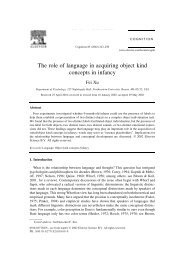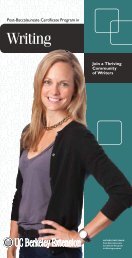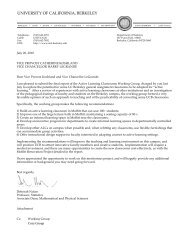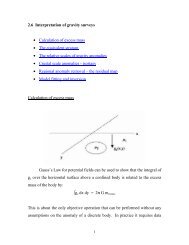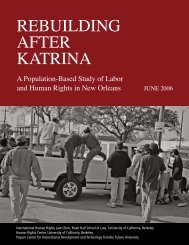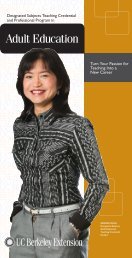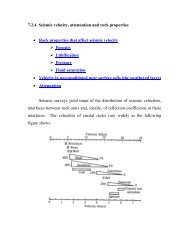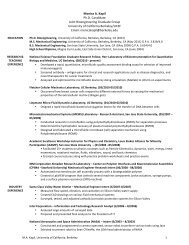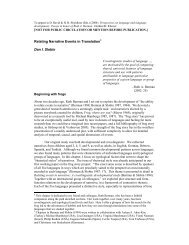From Lot's Wife to a Pillar of Salt: Evidence that Physical Object is a ...
From Lot's Wife to a Pillar of Salt: Evidence that Physical Object is a ...
From Lot's Wife to a Pillar of Salt: Evidence that Physical Object is a ...
Create successful ePaper yourself
Turn your PDF publications into a flip-book with our unique Google optimized e-Paper software.
© Blackwell Publ<strong>is</strong>hers Ltd. 1997, 108 Cowley Road, Oxford, OX4 1JF, UK<br />
and 350 Main Street, Malden, MA 02148, USA.<br />
Mind & Language, ISSN: 0268-1064<br />
Vol. 12. Nos. 3/4 September/December 1997, pp 365–392.<br />
<strong>From</strong> Lot’s <strong>Wife</strong> <strong>to</strong> a <strong>Pillar</strong> <strong>of</strong> <strong>Salt</strong>: <strong>Evidence</strong> <strong>that</strong><br />
<strong>Physical</strong> <strong>Object</strong> <strong>is</strong> a Sortal Concept<br />
FEI XU<br />
Abstract: A number <strong>of</strong> philosophers <strong>of</strong> language have proposed <strong>that</strong> people do not<br />
have conceptual access <strong>to</strong> ‘bare particulars’, or attribute-free individuals (e.g. Wiggins,<br />
1980). Individuals can only be picked out under some sortal, a concept which provides<br />
principles <strong>of</strong> individuation and identity. Many advocates <strong>of</strong> th<strong>is</strong> view have argued<br />
<strong>that</strong> object <strong>is</strong> not a genuine sortal concept. I will argue in th<strong>is</strong> paper <strong>that</strong> a narrow<br />
sense <strong>of</strong> ‘object’, namely the concept <strong>of</strong> any bounded, coherent, three-dimensional<br />
physical object <strong>that</strong> moves as a whole (Spelke, 1990) <strong>is</strong> a sortal for both infants and<br />
adults. Furthermore, object may be the infant’s first sortal and more specific sortals<br />
such as cup and dog may be acquired later in the first year <strong>of</strong> life. I will d<strong>is</strong>cuss the<br />
implications for infant categorization studies, trying <strong>to</strong> draw a conceptual d<strong>is</strong>tinction<br />
between a perceptual category and a sortal, and I will speculate on how a child may<br />
construct sortal concepts such as cup and dog.<br />
1. Introduction<br />
1.1 What Is a Sortal<br />
Since Frege (1884) first observed <strong>that</strong> one cannot count without specifying<br />
what <strong>to</strong> count, various philosophers and psycholog<strong>is</strong>ts <strong>of</strong> language have<br />
argued <strong>that</strong> certain concepts dubbed ‘sortals’, e.g. car, person, dog, 1 provide<br />
principles <strong>of</strong> individuation and numerical identity. These concepts tell us<br />
what <strong>to</strong> count as one instance <strong>of</strong> something and whether something <strong>is</strong> the<br />
same one as what we have seen before (Geach, 1962; Gupta, 1980; Wiggins,<br />
1980; Hirsch, 1982; Macnamara, 1987; Lowe, 1989a; Macnamara and Reyes,<br />
1994). Sortals are lexicalized as count nouns in natural languages <strong>that</strong> make<br />
the count/mass d<strong>is</strong>tinction. For example, a request <strong>to</strong> ‘count the red in th<strong>is</strong><br />
room’ cannot be complied with: Should a red shirt be counted as one or<br />
should the shirt, the two sleeves, and two pockets be counted separately so<br />
<strong>that</strong> we have five reds In contrast, a request <strong>to</strong> ‘count the red shirts in th<strong>is</strong><br />
I would like <strong>to</strong> thank Susan Carey, Lila Gleitman, Eli Hirsch, John Macnamara, Gary Marcus,<br />
Sandeep Prasada, Cr<strong>is</strong>tina Sorrentino, Elizabeth Spelke, Robert Stalnaker and Josh<br />
Tenenbaum for d<strong>is</strong>cussions <strong>of</strong> the subject matter and/or comments on earlier drafts <strong>of</strong> the<br />
paper. Portions <strong>of</strong> th<strong>is</strong> paper were presented at the 1995 Annual meeting <strong>of</strong> the Society<br />
for Philosophy and Psychology.<br />
Address for correspondence: Fei Xu, E10-244, Department <strong>of</strong> Brain and Cognitive Sciences,<br />
Massachusetts Institute <strong>of</strong> Technology, Cambridge, MA 02139, USA.<br />
Email: feipsyche.mit.edu.<br />
1<br />
Throughout the paper I will adopt the convention <strong>that</strong> all sortals be italicized and all<br />
mention <strong>of</strong> words be in quotes.
366 Mind & Language<br />
room’ will receive a definite answer: a red shirt (with its sleeves and pockets)<br />
should be counted as one shirt, not two. Hence the count noun ‘shirt’ gives<br />
us the principles for what <strong>to</strong> count as one shirt whereas the adjective ‘red’<br />
does not provide principles <strong>of</strong> counting. In general, other predicates besides<br />
count nouns, e.g. verbs or adjectives, do not serve the logical function <strong>of</strong><br />
providing principles <strong>of</strong> individuation. We cannot count ‘sleeping’ or ‘blue’<br />
unless we mean, e.g. count the naps you <strong>to</strong>ok or the blue birds.<br />
Sortals also provide principles <strong>of</strong> numerical identity. We cannot ask the<br />
question ‘<strong>is</strong> th<strong>is</strong> the same X’ without using a sortal <strong>to</strong> specify what X <strong>is</strong>.<br />
When a dog dies, even though we can trace a spatiotemporally connected<br />
path from the dog <strong>to</strong> its body, we nevertheless decide <strong>that</strong> the dog has gone<br />
out <strong>of</strong> ex<strong>is</strong>tence. Your dog and the neighbour’s dog are two different dogs<br />
whereas a certain puppy and a certain grown dog may be the same dog.<br />
Again, adjectives and other grammatical categories do not provide such<br />
principles <strong>of</strong> identity. For instance, the question whether something <strong>is</strong> ‘the<br />
same red’ does not have a definite answer unless we mean ‘the same shade<br />
<strong>of</strong> red’ or ‘the same red sweater’—count nouns such as ‘shade’ and ‘sweater’<br />
provide the principles <strong>of</strong> identity.<br />
1.2 Some Fundamentals <strong>of</strong> a Logic <strong>of</strong> Sortals<br />
The fact <strong>that</strong> these logical functions are uniquely fulfilled by natural language<br />
count nouns has led some philosophers <strong>of</strong> language <strong>to</strong> develop a logic <strong>of</strong> sortals<br />
(Gupta, 1980; Wiggins, 1980; Macnamara and Reyes, 1994 among others). The<br />
fundamental tenet <strong>of</strong> a logic <strong>of</strong> sortals <strong>is</strong> there are no bare particulars; wecannot<br />
enumerate or trace identity without the support <strong>of</strong> a sortal. ‘Bare particulars’<br />
are the alleged individuals <strong>that</strong> have no properties <strong>of</strong> their own whatsoever but<br />
still serve as entities on which <strong>to</strong> hang properties. Suppose someone <strong>is</strong> pointing<br />
at some part <strong>of</strong> the v<strong>is</strong>ual scene and uttering the word ‘<strong>that</strong>’. The demonstrative<br />
‘<strong>that</strong>’ may refer <strong>to</strong> a bare particular. It does not pick out an individual for which<br />
we can trace identity over time. We may be able <strong>to</strong> figure out <strong>that</strong> the person<br />
intends <strong>to</strong> pick out part <strong>of</strong> the v<strong>is</strong>ual scene with a table present, but we would<br />
not know whether the person <strong>is</strong> pointing <strong>to</strong> the table, a colour patch <strong>of</strong> the<br />
table, the millions <strong>of</strong> molecules <strong>of</strong> the table, or the table plus the d<strong>is</strong>h <strong>that</strong> <strong>is</strong><br />
sitting on it. The logic <strong>of</strong> sortals contrasts with standard model-theoretic<br />
semantics, in which the logical form for ‘Some person <strong>is</strong> tall’ in predicate<br />
calculus <strong>is</strong> ‘∃x (person (x) & tall (x))’. In th<strong>is</strong> formulation, x <strong>is</strong> a bare particular—it<br />
<strong>is</strong> an individual with no properties <strong>of</strong> its own but it still supports<br />
properties such as ‘being a person’ or ‘<strong>is</strong> tall’. The champion <strong>of</strong> the logic <strong>of</strong><br />
sortals denies <strong>that</strong> we have conceptual access <strong>to</strong> bare particulars. 2<br />
2<br />
The reviewers <strong>of</strong> an earlier version <strong>of</strong> th<strong>is</strong> paper pointed out <strong>to</strong> me <strong>that</strong> standard modeltheoretic<br />
semantics <strong>is</strong> an all-purpose <strong>to</strong>ol and it should not be accused <strong>of</strong> having any<br />
inbuilt metaphysical bias <strong>to</strong> ‘bare particulars’. However, if a semantic theory intends <strong>to</strong><br />
be psychologically real, the formal<strong>is</strong>ms <strong>of</strong> standard model-theoretic semantics do carry<br />
with them the commitment <strong>to</strong> bare particulars.<br />
© Blackwell Publ<strong>is</strong>hers Ltd. 1996
<strong>Physical</strong> <strong>Object</strong> as a Sortal Concept 367<br />
Besides the stricture against bare particulars, three other important tenets<br />
<strong>of</strong> a logic <strong>of</strong> sortals are relevant <strong>to</strong> the present d<strong>is</strong>cussion. First, a principled<br />
d<strong>is</strong>tinction should be made between count nouns and other grammatical<br />
categories; second, the principles <strong>of</strong> individuation and identity supported by<br />
sortals cannot be reduced <strong>to</strong> some basic notion <strong>of</strong> spatiotemporal continuity;<br />
third, within the class <strong>of</strong> sortals, a d<strong>is</strong>tinction should be made between substance<br />
and stage (or phase) sortals.<br />
Consider first the d<strong>is</strong>tinction between count nouns and other grammatical<br />
categories. Count nouns denote kinds which provide principles and criteria<br />
for individuation and identity whereas other grammatical categories do not.<br />
Adjectives and other predicates are predicates <strong>of</strong> the individuals sorted by<br />
count nouns; their interpretations <strong>of</strong>ten depend on which count nouns they<br />
are predicated <strong>of</strong>, e.g. ‘good’ as in ‘a good person’ means something rather<br />
different from ‘good’ as in ‘a good thief’.<br />
Second, principles <strong>of</strong> individuation and identity provided by sortals may<br />
override our basic criteria <strong>of</strong> identity based on spatiotemporal continuity.<br />
To borrow an example from Hirsch (1982): A car consigned <strong>to</strong> a crusher<br />
follows a spatiotemporally continuous path in the crushing process and it<br />
gradually becomes a pile <strong>of</strong> metal and plastic, but nevertheless at some point,<br />
we decide <strong>that</strong> the car has gone out <strong>of</strong> ex<strong>is</strong>tence. Th<strong>is</strong> <strong>is</strong> because the sortal<br />
car provides the criteria for what counts as a car.<br />
Third, there <strong>is</strong> a d<strong>is</strong>tinction between substance and stage (or phase) sortals<br />
(Wiggins, 1980). In a nutshell, a count noun <strong>is</strong> a substance sortal if instances<br />
<strong>of</strong> the sortal it denotes cease <strong>to</strong> ex<strong>is</strong>t when they cease <strong>to</strong> be members <strong>of</strong> the<br />
sortal, e.g. person, dog, tree, car. In other words, substance sortals sat<strong>is</strong>fy the<br />
condition <strong>that</strong> once something <strong>is</strong> no longer an X, it <strong>is</strong> also ‘no longer’. For<br />
example, when a person dies, he ceases <strong>to</strong> be a member <strong>of</strong> the sortal person<br />
and he goes out <strong>of</strong> ex<strong>is</strong>tence. Hence ‘person’ <strong>is</strong> a substance sortal. Substance<br />
sortals contrast with phase sortals such as baby or tadpole, which do not have<br />
th<strong>is</strong> property—a baby does not cease <strong>to</strong> ex<strong>is</strong>t when she grows up even<br />
though she or he <strong>is</strong> no longer a member <strong>of</strong> the sortal baby. Similarly, a tadpole<br />
does not cease <strong>to</strong> ex<strong>is</strong>t when it becomes a frog although it <strong>is</strong> no longer<br />
a member <strong>of</strong> the sortal tadpole. For Wiggins (1980), only substance sortals<br />
stand for genuine kinds in a metaphysical sense.<br />
A logic <strong>of</strong> sortals has been <strong>of</strong>fered as an alternative for formalizing natural<br />
languages such as Engl<strong>is</strong>h. As mentioned above, standard model-theoretic semantics<br />
posits bare particulars, i.e. attribute-free individuals. Recently, Macnamara<br />
and Reyes (1994) have argued <strong>that</strong> in order <strong>to</strong> have a psychologically real<br />
semantics, we need a better formal<strong>is</strong>m for a natural language like Engl<strong>is</strong>h,<br />
which would take in<strong>to</strong> account the fact <strong>that</strong> individuals have <strong>to</strong> be typed by<br />
sortals. For example, the logical translation for ‘the man <strong>is</strong> tall’ <strong>is</strong> better represented<br />
as ‘∃ (x: man) (tall (x: man))’—<strong>to</strong> be read as ‘There <strong>is</strong> a man such <strong>that</strong><br />
he <strong>is</strong> tall’. In th<strong>is</strong> formal<strong>is</strong>m, there <strong>is</strong> no x <strong>that</strong> stands by itself without the<br />
support <strong>of</strong> a sortal such as man. The grammatical d<strong>is</strong>tinction between ‘man’<br />
and ‘<strong>is</strong> tall’ <strong>is</strong> also respected in <strong>that</strong> the interpretation <strong>of</strong> the predicate ‘tall’ now<br />
depends on which sortal it modifies. Employing a branch <strong>of</strong> mathematics,<br />
© Blackwell Publ<strong>is</strong>hers Ltd. 1996
368 Mind & Language<br />
namely category theory, Macnamara, Reyes, and their colleagues have<br />
developed a detailed theory <strong>of</strong> kinds/sortals. Their system <strong>of</strong> kinds <strong>is</strong> a system<br />
<strong>of</strong> underlying maps among kinds, instead <strong>of</strong> the standard formulation <strong>of</strong> kinds<br />
as class inclusions (see Macnamara and Reyes, 1994, for details).<br />
1.3 <strong>Object</strong> and Thing: Candidate Bare Particulars or General, Universal<br />
Sortals<br />
It <strong>is</strong> crucial for sortal theor<strong>is</strong>ts such as Macnamara <strong>that</strong> people have no conceptual<br />
access <strong>to</strong> bare particulars. If they did, we would not need a logic <strong>of</strong><br />
sortals <strong>to</strong> represent the semantics <strong>of</strong> natural languages: All count nouns as<br />
well as other grammatical categories could then be construed as predicates<br />
<strong>of</strong> these bare particulars.<br />
Bare particulars may be devastating for the sortal approach <strong>to</strong> semantics, but<br />
even a general, universal sortal, as sortal theor<strong>is</strong>ts believe, would cause serious<br />
damage. Finding a general, universal sortal entails <strong>that</strong> all other sortals, e.g.<br />
dog or car, would be d<strong>is</strong>pensable because they could be construed as predicates<br />
<strong>of</strong> th<strong>is</strong> general, universal sortal. Note th<strong>is</strong> would be a rough equivalent <strong>of</strong> finding<br />
a bare particular—other count nouns as well as predicates such as verbs<br />
and adjectives would be construed as predicates <strong>of</strong> th<strong>is</strong> general, universal sortal.<br />
If such a general sortal ex<strong>is</strong>ted, we would not need <strong>to</strong> draw a sharp line<br />
between count nouns and other grammatical categories, and predicate calculus<br />
could be only slightly modified in order <strong>to</strong> represent natural language semantics:<br />
We could replace the xs with th<strong>is</strong> general sortal.<br />
One might ask why the sortal theor<strong>is</strong>ts ins<strong>is</strong>t on dog, tree and person being<br />
the right level <strong>of</strong> specificity for sortal-hood. Implicitly or explicitly, all sortal<br />
theor<strong>is</strong>ts agree <strong>that</strong> a sortal should provide a sat<strong>is</strong>fac<strong>to</strong>ry answer <strong>to</strong> the question<br />
‘What <strong>is</strong> it’ (Wiggins, 1980). Dog, tree and person certainly fulfil th<strong>is</strong> requirement.<br />
Furthermore, the psychological literature on kind concepts suggests <strong>that</strong> these<br />
‘basic-level’ sortals enjoy a privileged psychological status (Rosch et al., 1976).<br />
A first glance at a natural language such as Engl<strong>is</strong>h, however, seems <strong>to</strong><br />
give us some candidates for either bare particulars or general, universal sortals.<br />
Count nouns such as ‘object’, ‘thing’ or ‘entity’ give the appearance <strong>of</strong><br />
being either individuals <strong>that</strong> have no properties <strong>of</strong> their own but still serve<br />
as individuals on which <strong>to</strong> hang properties, or general sortals <strong>that</strong> other<br />
specific sortals (e.g. dog, car) may be predicates <strong>of</strong>.<br />
Not surpr<strong>is</strong>ingly, sortal theor<strong>is</strong>ts have argued <strong>that</strong> ‘object’, ‘thing’ and<br />
‘entity’ are not sortal concepts. For example, Wiggins (1980) says, ‘For a<br />
formal concept like entity or substance has no au<strong>to</strong>nomous individuative force<br />
<strong>of</strong> its own, and must be variously supplemented, wherever it appears in<br />
contexts <strong>of</strong> identification, according <strong>to</strong> the kind <strong>of</strong> the individual in question’<br />
(p. 63). ‘Material object <strong>is</strong> now ruled out from sortal status, and so are other<br />
dummy substantives, . . .’ (p. 64). That <strong>is</strong>, Wiggins explicitly denies <strong>that</strong><br />
‘object’ and ‘entity’ are sortals.<br />
Three types <strong>of</strong> arguments have been put forth against ‘object’ or ‘thing’<br />
being a sortal. The first type <strong>is</strong> <strong>that</strong> natural language terms such as ‘object’<br />
© Blackwell Publ<strong>is</strong>hers Ltd. 1996
<strong>Physical</strong> <strong>Object</strong> as a Sortal Concept 369<br />
or ‘thing’ do not provide principles <strong>of</strong> individuation (Wiggins, 1980; Macnamara,<br />
1987, 1994; La Palme Reyes et al., 1994). Macnamara (1994) says it<br />
clearly: ‘We cannot conceptually grasp an individual in a universal kind<br />
supposedly denoted by the count noun “thing” or “object”’ (p. 20). The reason<br />
<strong>is</strong> <strong>that</strong> ‘thing’ or ‘object’ does not tell us what <strong>to</strong> count as one instance.<br />
If you were <strong>to</strong> count the things in the room, you might count the chair as<br />
a chair, four legs, plus one <strong>to</strong>p. Hence six things al<strong>to</strong>gether! Similarly, Hirsch<br />
(1982) claims <strong>that</strong> at least the broadest sense <strong>of</strong> the word ‘object’ <strong>is</strong> not a<br />
sortal: ‘There may possibly be a completely perm<strong>is</strong>sive sense <strong>of</strong> the word<br />
“object” which applies in fact <strong>to</strong> any aggregate <strong>of</strong> matter, however spatially<br />
d<strong>is</strong>continuous’ (p. 97). Th<strong>is</strong> sense <strong>of</strong> ‘object’, or even the sense <strong>of</strong> the ‘object’<br />
<strong>that</strong> applies <strong>to</strong> any arbitrary continuous portion <strong>of</strong> matter, certainly does not<br />
give us countable individuals.<br />
The second type <strong>of</strong> argument <strong>is</strong> <strong>that</strong> ‘object’ or ‘thing’ does not provide<br />
principles <strong>of</strong> numerical identity. The Old Testament (Genes<strong>is</strong>, chapter 19)<br />
tells the s<strong>to</strong>ry <strong>of</strong> Lot’s wife. Lot and h<strong>is</strong> wife were <strong>to</strong>ld by the Lord ‘Escape<br />
for thy life; look not behind thee. . . . Then the Lord rained upon Sodom and<br />
upon Gomorrah brims<strong>to</strong>ne and fire from the Lord out <strong>of</strong> heaven. . . . But h<strong>is</strong><br />
wife looked back from behind [Lot] and she became a pillar <strong>of</strong> salt.’ Wiggins<br />
(1980) claims <strong>that</strong> in th<strong>is</strong> process, nothing pers<strong>is</strong>ted through time: Lot’s wife<br />
ceased <strong>to</strong> ex<strong>is</strong>t and a pillar <strong>of</strong> salt came in<strong>to</strong> being. According <strong>to</strong> Wiggins,<br />
there <strong>is</strong> no sortal concept, e.g. object or thing, <strong>that</strong> could answer the question<br />
<strong>of</strong> ‘same what’ for Lot’s wife and the pillar <strong>of</strong> salt. He argues <strong>that</strong> short <strong>of</strong><br />
inventing a sortal concept woman-pillar, ‘certainly there <strong>is</strong> no substantial sortal,<br />
. . . suitable <strong>to</strong> cover the identity between Lot’s wife and the forty foot<br />
pillar <strong>of</strong> salt <strong>that</strong> <strong>is</strong> still <strong>to</strong> be encountered even now on the Jebel Usdum<br />
near the Dead Sea’ (p. 61). The difficulty with object or thing as candidate<br />
sortal concept in Lot’s s<strong>to</strong>ry, as I understand Wiggins, ar<strong>is</strong>es from the fact<br />
<strong>that</strong> in th<strong>is</strong> s<strong>to</strong>ry, an entity starts <strong>of</strong>f with the pers<strong>is</strong>tence principle <strong>of</strong> one<br />
kind (i.e. woman), then exchanges <strong>that</strong> principle for the pers<strong>is</strong>tence principle<br />
<strong>of</strong> another kind (i.e. pillar <strong>of</strong> salt). In addition, Wiggins believes <strong>that</strong> the s<strong>to</strong>ry<br />
<strong>of</strong> Lot’s wife <strong>is</strong> incoherent because it violates actual laws <strong>of</strong> nature.<br />
Finally, terms such as ‘object’ or ‘thing’ may be less good candidates for<br />
answering the question ‘what <strong>is</strong> it’. If one were <strong>to</strong> ask the question ‘what<br />
<strong>is</strong> it’, an answer such as ‘a cup’ or ‘a person’ would suffice. But if the answer<br />
were <strong>to</strong> be ‘a thing’ or ‘an object’, we still would not have any idea what<br />
<strong>that</strong> thing <strong>is</strong>! It <strong>is</strong> peculiar <strong>that</strong> ‘object’ and ‘thing’ are nevertheless lexicalized<br />
as count nouns even though they don’t seem <strong>to</strong> behave in the same way as<br />
most other count nouns, i.e. they are not used <strong>to</strong> answer the question ‘what<br />
<strong>is</strong> it’. One explanation may be <strong>that</strong> these nouns are place-holders and not<br />
true sortals.<br />
Although the Engl<strong>is</strong>h words ‘object’ and ‘thing’ may not be sortals, as argued<br />
above by philosophers <strong>of</strong> language, I will argue in th<strong>is</strong> paper <strong>that</strong> for both adults<br />
and young infants, there <strong>is</strong> nonetheless a sortal, physical object, which<strong>is</strong>more<br />
general than person, car or tree. A physical object <strong>is</strong> defined as any three-dimensional,<br />
bounded entity <strong>that</strong> moves on a spatiotemporally continuous path<br />
© Blackwell Publ<strong>is</strong>hers Ltd. 1996
370 Mind & Language<br />
(Spelke, 1990; see also Jackend<strong>of</strong>f, 1983). The Engl<strong>is</strong>h word ‘object’ has multiple<br />
senses; th<strong>is</strong> concept <strong>of</strong> physical object corresponds <strong>to</strong> one <strong>of</strong> the senses. In the<br />
rest <strong>of</strong> the paper, I will defend the claim <strong>that</strong> physical object (<strong>that</strong> <strong>is</strong>, one sense<br />
<strong>of</strong> the Engl<strong>is</strong>h word ‘object’) <strong>is</strong> a sortal. Section 2 provides evidence <strong>that</strong> physical<br />
object <strong>is</strong> the first sortal for young infants. Section 3 provides evidence <strong>that</strong> physical<br />
object <strong>is</strong> a sortal for adults and <strong>that</strong> the aforementioned arguments against<br />
‘object’ being a sortal may be remedied. Section 4 d<strong>is</strong>cusses the relation between<br />
physical object and other more specific sortals. Section 5 d<strong>is</strong>cusses the advantages<br />
<strong>of</strong> building physical object as infants’ first sortal concept and finally, in Section 6,<br />
some possible learning mechan<strong>is</strong>ms which would allow infants <strong>to</strong> construct<br />
more specific sortals are d<strong>is</strong>cussed.<br />
2. <strong>Evidence</strong> from Infants: <strong>Physical</strong> <strong>Object</strong> as Their First Sortal<br />
The philosophical literature on numerical identity generally agrees <strong>that</strong> any<br />
explication <strong>of</strong> the concept <strong>of</strong> identity should sat<strong>is</strong>fy Leibniz’s Law (with the<br />
exception <strong>of</strong> relativ<strong>is</strong>ts such as Geach): If x <strong>is</strong> identical <strong>to</strong> y, x and y should<br />
have exactly the same properties. Although Leibniz’s Law <strong>is</strong> logically necessary<br />
and sufficient for numerical identity, it does not give us a psychological<br />
notion <strong>of</strong> how things pers<strong>is</strong>t through time and space. A psychologically real<br />
explication <strong>of</strong> the concept <strong>of</strong> identity, however, should include people’s criteria<br />
for pers<strong>is</strong>tence over time, <strong>that</strong> <strong>is</strong>, how people decide whether something<br />
<strong>is</strong> the same one they have seen before.<br />
Our criteria for individuation and identity <strong>of</strong> physical objects may be<br />
roughly divided in<strong>to</strong> two types: spatiotemporal information and property/<br />
kind (or sortal) information. The spatiotemporal criteria include the following<br />
generalizations: (1) one object cannot be at two places at the same time; (2)<br />
twoobjectscannotbeatthesameplaceatthesametime;(3)objectstravelon<br />
spatiotemporally connected paths. No object can move from point A <strong>to</strong> point B<br />
without traversing a continuous path in between; if some object appears <strong>to</strong> have<br />
travelled on a spatiotemporally d<strong>is</strong>continuous path, people judge <strong>that</strong> there<br />
must be two objects involved. The property/kind criteria include the following<br />
generalizations: (1) upon seeing a member <strong>of</strong> a kind now (e.g. a cup) and a<br />
member <strong>of</strong> a different kind (e.g. a dog) at a later time, we infer there are two<br />
numerically d<strong>is</strong>tinct entities; (2) upon seeing a member <strong>of</strong> a kind now (e.g. a<br />
red block) and a member <strong>of</strong> the same kind with a different property (e.g. a<br />
blue block) at a later time, we (<strong>of</strong>ten) infer there are two numerically d<strong>is</strong>tinct<br />
entities. Note <strong>that</strong> the spatiotemporal criteria apply <strong>to</strong> all physical objects,<br />
regardless <strong>of</strong> kinds <strong>of</strong> object. The property/kind criteria, on the other hand, are<br />
kind-relative. Certain property changes signal a change in identity only within<br />
certain kinds <strong>of</strong> objects. For example, if you see a small chair in the corner now<br />
and a big chair there later, you infer <strong>that</strong> there are two numerically d<strong>is</strong>tinct<br />
chairs. But if you see a small plant in the corner now and a larger one there a<br />
few months later, it <strong>is</strong> not necessarily the case <strong>that</strong> there are two d<strong>is</strong>tinct plants.<br />
Oneway<strong>to</strong>seewhatsortalsadultsorinfantsrepresent<strong>is</strong>byprobingwhat<br />
criteria they use in individuation and identity judgments.<br />
© Blackwell Publ<strong>is</strong>hers Ltd. 1996
<strong>Physical</strong> <strong>Object</strong> as a Sortal Concept 371<br />
2.1 <strong>Evidence</strong> for <strong>Object</strong> as a Sortal in Infancy<br />
Psychological investigations have focused on what criteria are employed for<br />
individuating objects and deciding whether something <strong>is</strong> the same one as seen<br />
before. Piaget and T.G.R. Bower first ra<strong>is</strong>ed these questions with young infants.<br />
Bower (1974/1982) presented some experimental evidence <strong>that</strong> very young<br />
infants use spatiotemporal rules <strong>to</strong> trace identity, but <strong>that</strong> before 5 months <strong>of</strong><br />
age they do not use property differences <strong>to</strong> infer change <strong>of</strong> identity. In addition,<br />
he claimed <strong>that</strong> infants were guided by different spatiotemporal rules from<br />
adults: for infants, stationary and moving objects are numerically d<strong>is</strong>tinct. Bower<br />
employed a v<strong>is</strong>ual tracking paradigm in these studies. The rationale for the<br />
method was <strong>that</strong> if the infants detected something unexpected or novel, their<br />
tracking behaviour would be interrupted. In one experiment, infants learned <strong>to</strong><br />
track moving objects by turning their heads. In the test trials, the moving objects<br />
would suddenly s<strong>to</strong>p. Bower found <strong>that</strong> infants kept turning their heads when<br />
the object s<strong>to</strong>pped. He interpreted these results as showing <strong>that</strong> the infants<br />
thought <strong>that</strong> the moving object would continue <strong>to</strong> move along its path and the<br />
stationary object (which was moving until it s<strong>to</strong>pped suddenly) was a different<br />
object. In the second experiment, Bower tested whether infants used property<br />
differences <strong>to</strong> establ<strong>is</strong>h object identity. A moving object, say a bunny, would<br />
d<strong>is</strong>appear behind a screen, then another object, say a ball, would appear from<br />
behind the screen. Bower found <strong>that</strong> young infants kept tracking the new object<br />
and did not look back <strong>to</strong> the screen. He interpreted these results as showing<br />
<strong>that</strong> infants did not make the inference <strong>that</strong> the ball was a different object from<br />
the bunny. By 5 months <strong>of</strong> age, however, infants looked back at the screen.<br />
Bower interpreted th<strong>is</strong> as indicating <strong>that</strong> infants realized <strong>that</strong> the ball and the<br />
bunny were two different objects and the bunny must have stayed behind<br />
the screen.<br />
There are a number <strong>of</strong> serious methodological flaws in these experiments:<br />
the failure <strong>to</strong> s<strong>to</strong>p head turning in the first experiment may be due <strong>to</strong> the<br />
fact <strong>that</strong> young infants do not have very good neck control at th<strong>is</strong> age and<br />
hence cannot inhibit the head-turning motion when the object s<strong>to</strong>ps; the<br />
failure <strong>to</strong> look back at the screen in the second experiment could be due <strong>to</strong><br />
a similar fac<strong>to</strong>r, or alternatively, it could be due <strong>to</strong> the fact <strong>that</strong> the infants<br />
were well aware <strong>that</strong> the ball was a different object from the bunny, but<br />
kept tracking because <strong>of</strong> its novelty. Furthermore, a number <strong>of</strong> researchers<br />
either failed <strong>to</strong> replicate Bower’s findings or found <strong>that</strong> the looking back<br />
behaviour was a function <strong>of</strong> the speed at which the objects were moving but<br />
not a function <strong>of</strong> the property differences; <strong>that</strong> <strong>is</strong>, the looking back behaviour<br />
occurred equally <strong>of</strong>ten when the same object as opposed <strong>to</strong> a different object<br />
emerged from behind the screen (Muller and Aslin, 1978; Meicler and<br />
Gratch, 1980; Gratch, 1982).<br />
In sum, Bower’s experiments do not give us any clear evidence about<br />
infants’ criteria for object identity. However, h<strong>is</strong> conjecture <strong>that</strong> infants use<br />
spatiotemporal information before using property information <strong>to</strong> trace identity<br />
may be on the right track. There <strong>is</strong> now considerable evidence in the<br />
© Blackwell Publ<strong>is</strong>hers Ltd. 1996
372 Mind & Language<br />
Figure 1 Schematic representation <strong>of</strong> the Spelke et al. (1995) experiment<br />
infant cognition literature suggesting <strong>that</strong> infants as young as 4 or 5 months<br />
use all three spatiotemporal generalizations <strong>to</strong> individuate objects and trace<br />
identity, just like adults. But unlike adults, they do not use property/kind<br />
information until about 10 <strong>to</strong> 12 months <strong>of</strong> age.<br />
In the last decade or so, a methodology has been developed <strong>to</strong> study the<br />
cognitive capacities <strong>of</strong> pre-verbal infants (Spelke, 1985). In th<strong>is</strong> method,<br />
infants are shown the same event repeatedly and their looking times<br />
recorded. With each repetition their looking times decline, <strong>that</strong> <strong>is</strong>, infants<br />
‘habituate’. When infants reach a pre-set habituation criterion, they are<br />
shown two d<strong>is</strong>plays alternately, one cons<strong>is</strong>tent with adults’ understanding<br />
<strong>of</strong> the event and the other incons<strong>is</strong>tent. If the infants have the same understanding<br />
<strong>of</strong> the habituation event as adults, they should look longer at the<br />
incons<strong>is</strong>tent d<strong>is</strong>play as opposed <strong>to</strong> the cons<strong>is</strong>tent one. In a seminal study,<br />
Spelke et al. (1995) showed <strong>that</strong> 4-month-old infants take evidence <strong>of</strong> spatiotemporal<br />
d<strong>is</strong>continuity as evidence for numerically d<strong>is</strong>tinct objects. In th<strong>is</strong><br />
experiment, two screens were lowered on<strong>to</strong> the stage with some space in<br />
between them (see Figure 1 for a schematic representation <strong>of</strong> the event using<br />
different objects). The infant saw <strong>that</strong> a rod appeared from behind one<br />
screen, say the left one, moved <strong>to</strong> the left end <strong>of</strong> the stage, then returned<br />
behind the left screen. No object appeared between the two screens. After a<br />
© Blackwell Publ<strong>is</strong>hers Ltd. 1996
<strong>Physical</strong> <strong>Object</strong> as a Sortal Concept 373<br />
Figure 2 Schematic representation <strong>of</strong> the Baillargeon et al. (1985) experiment<br />
short pause, a physically identical rod appeared from behind the right<br />
screen, moved <strong>to</strong> the right end <strong>of</strong> the stage, then returned behind the right<br />
screen. Th<strong>is</strong> event was repeated until the infant reached a habituation criterion,<br />
which was defined as the average looking time <strong>of</strong> the last three<br />
habituation trials being half <strong>of</strong> the first three trials or less. The screens were<br />
then removed <strong>to</strong> reveal one <strong>of</strong> two outcomes: the expected outcome <strong>of</strong> two<br />
identical rods or the unexpected outcome <strong>of</strong> just a single rod. The infants<br />
looked longer at the one-rod outcome, suggesting <strong>that</strong> they, like adults, had<br />
expected two rods and were surpr<strong>is</strong>ed <strong>to</strong> see just one. When the rod did<br />
appear in the space between the two screens, on the other hand, the infants<br />
looked about equally at the one-rod and two-rod outcomes, as if undecided<br />
as <strong>to</strong> how many rods were behind the screens. Xu and Carey (1996) replicated<br />
the above finding with 10-month-olds using a rather different set <strong>of</strong><br />
objects, e.g. <strong>to</strong>y ducks, balls, elephants and trucks.<br />
Baillargeon et al. (1985) presented evidence <strong>that</strong> 5-month-old infants<br />
understand <strong>that</strong> two objects cannot be at the same place at the same time.<br />
In these experiments a rotating screen facing the infants was introduced.<br />
After the infant had habituated <strong>to</strong> the rotating screen going 180° <strong>to</strong>wards<br />
then away from her in a drawbridge fashion, a box was introduced and<br />
placed behind the screen. The rotation resumed and sometimes the screen<br />
s<strong>to</strong>pped short <strong>of</strong> 180° (the expected event because the box was behind it)<br />
and sometimes the screen rotated all the way back <strong>to</strong> 180° (the unexpected<br />
event if the infant unders<strong>to</strong>od <strong>that</strong> two objects cannot occupy the same space<br />
at the same time; see Figure 2). Infants looked reliably longer at the unexpected<br />
event, suggesting <strong>that</strong> they expected the box <strong>to</strong> remain behind the screen<br />
and <strong>that</strong> the two objects, the screen and the box cannot occupy the same<br />
space at the same time.<br />
In addition, Baillargeon and Graber (1987) showed <strong>that</strong> 5-month-old<br />
© Blackwell Publ<strong>is</strong>hers Ltd. 1996
374 Mind & Language<br />
Figure 3 Schematic representation <strong>of</strong> the Baillargeon and Graber (1987)<br />
experiment<br />
infants understand <strong>that</strong> one object cannot be at two places at the same time.<br />
In one <strong>of</strong> the experiments, infants were habituated <strong>to</strong> a tall rabbit going<br />
behind a screen and appearing on the other side (see Figure 3). Then the<br />
middle section <strong>of</strong> the <strong>to</strong>p half <strong>of</strong> the screen was removed so <strong>that</strong> the tall<br />
rabbit should appear in th<strong>is</strong> ‘window’. If the rabbit did not appear in the<br />
window, the infants looked longer than if the rabbit did appear in the window.<br />
But if the infants were shown two identical tall rabbits simultaneously,<br />
one on each side <strong>of</strong> the screen, they did not look longer when no rabbit<br />
appeared in the window. Infants could only succeed if they interpreted the<br />
two identical-looking rabbits as two d<strong>is</strong>tinct rabbits using the location information.<br />
In other words, if shown two objects simultaneously, the infants set<br />
up representations <strong>of</strong> two numerically d<strong>is</strong>tinct objects <strong>that</strong> allowed them <strong>to</strong><br />
resolve an apparent violation <strong>of</strong> spatiotemporal continuity.<br />
Researchers have argued <strong>that</strong> in these experiments, infants are able <strong>to</strong> keep<br />
track <strong>of</strong> d<strong>is</strong>crete physical objects. However, it <strong>is</strong> possible <strong>that</strong> the infants kept<br />
track <strong>of</strong> the amount <strong>of</strong> stuff in some <strong>of</strong> the experiments. That <strong>is</strong>, these results<br />
may not speak <strong>to</strong> the infants’ representations <strong>of</strong> physical objects (which<br />
requires quantification <strong>of</strong> d<strong>is</strong>crete individuals) but rather their ability <strong>to</strong> keep<br />
track <strong>of</strong> amounts <strong>of</strong> stuff (which only requires continuous quantification).<br />
However, experiments by Huntley-Fenner and Carey (1995) suggest <strong>that</strong><br />
infants in these experiments apparently quantified over objects as d<strong>is</strong>crete<br />
entities and did not simply keep track <strong>of</strong> the amount <strong>of</strong> stuff present in an<br />
array. In several experiments with 8-month-old infants, they showed <strong>that</strong> if<br />
sand <strong>is</strong> poured on<strong>to</strong> a stage behind a screen, infants fail <strong>to</strong> count the number<br />
© Blackwell Publ<strong>is</strong>hers Ltd. 1996
<strong>Physical</strong> <strong>Object</strong> as a Sortal Concept 375<br />
Figure 4 Schematic representation <strong>of</strong> the Huntley-Fenner and Carey (1995)<br />
experiment<br />
<strong>of</strong> piles while succeeding in a similar experiment with objects (see Figure 4).<br />
In other words, infants do not seem <strong>to</strong> track the amount <strong>of</strong> stuff present in<br />
an event, which suggests <strong>that</strong> in the experiments involving solid objects,<br />
they quantified over individuals.<br />
There are at least two interpretations <strong>of</strong> which sortals underlie the capacity<br />
revealed by the above experiments. One <strong>is</strong> <strong>that</strong> infants represent specific<br />
sortals such as rod, box, rabbit, and others. After all, all sortals (which refer<br />
<strong>to</strong> physical entities in the world) are subject <strong>to</strong> the spatiotemporal constraints<br />
on individuation and identity. However, a more conservative interpretation<br />
<strong>is</strong> <strong>that</strong> the sortal concept underlying these successes <strong>is</strong> physical object, since<br />
the spatiotemporal criteria apply <strong>to</strong> all physical objects regardless <strong>of</strong> whether<br />
the objects are ducks or cups. None <strong>of</strong> the above experiments required any<br />
representation <strong>of</strong> individuation and identity criteria for specific sortals.<br />
<strong>Physical</strong> object <strong>is</strong> a sortal because it provides criteria for individuation and<br />
numerical identity; these criteria are spatiotemporal in nature. Further evidence<br />
<strong>is</strong> needed <strong>to</strong> decide which interpretation <strong>of</strong> these results <strong>is</strong> correct.<br />
© Blackwell Publ<strong>is</strong>hers Ltd. 1996
376 Mind & Language<br />
Figure 5 Schematic representation <strong>of</strong> the property/kind condition <strong>of</strong> Xu and<br />
Carey (1996)<br />
2.2 <strong>Evidence</strong> for <strong>Object</strong> as the First Sortal in Infancy<br />
Do young infants also represent more specific sortals such as ball or bottle<br />
or do they only represent the sortal physical object Xu and Carey (1996)<br />
dev<strong>is</strong>ed further experiments <strong>to</strong> address th<strong>is</strong> question. For ‘ball’ or ‘bottle’ <strong>to</strong><br />
be a sortal, minimally the infant should be able <strong>to</strong> use the differences<br />
between a bottle and a ball <strong>to</strong> set up representations <strong>of</strong> two numerically<br />
d<strong>is</strong>tinct individuals. In these experiments, a single screen was lowered on<br />
the stage. Ten-month-old infants saw <strong>that</strong> a ball appeared from behind the<br />
screen, moved <strong>to</strong> the left end <strong>of</strong> the stage and s<strong>to</strong>pped. The infant’s looking<br />
time was moni<strong>to</strong>red, then the ball returned behind the screen. After a short<br />
pause, a bottle appeared from behind the screen, moved <strong>to</strong> the right end <strong>of</strong><br />
the stage and s<strong>to</strong>pped. Again the infant looked at it until she turned away,<br />
then the bottle returned behind the screen. After habituation, the screen was<br />
removed, revealing either two objects, a ball and a bottle (expected outcome),<br />
or only one <strong>of</strong> the two objects (unexpected outcome); see Figure 5. If the<br />
infant <strong>is</strong> able <strong>to</strong> use the property/kind (or sortal) difference between the ball<br />
and the bottle <strong>to</strong> infer two d<strong>is</strong>tinct objects, she should look longer at the one<br />
object outcome. Surpr<strong>is</strong>ingly, these 10-month-old infants failed <strong>to</strong> look<br />
longer at the unexpected one-object outcome. They simply exhibited a base-<br />
© Blackwell Publ<strong>is</strong>hers Ltd. 1996
<strong>Physical</strong> <strong>Object</strong> as a Sortal Concept 377<br />
Figure 6 Schematic representation <strong>of</strong> the spatiotemporal condition <strong>of</strong> Xu and<br />
Carey (1996)<br />
line preference for looking longer at two objects. Success in th<strong>is</strong> task may or<br />
may not show <strong>that</strong> the infants represent sortals such as ball or bottle, because<br />
as adults, we can also use the property difference within a single sortal, say,<br />
a red ball and a blue ball, <strong>to</strong> infer two balls, but the failure certainly suggests<br />
<strong>that</strong> they do not represent sortals ball or bottle. To ensure <strong>that</strong> the result in<br />
th<strong>is</strong> experiment was not an artifact <strong>of</strong> the method we employed, a control<br />
version was carried out. The infants were simply shown the two objects<br />
simultaneously at the beginning <strong>of</strong> the experiment; <strong>that</strong> <strong>is</strong>, they were given<br />
spatiotemporal evidence <strong>that</strong> there were two objects (see Figure 6). The<br />
experiment then unfolded as before and the outcomes were the same as<br />
before. The infants in th<strong>is</strong> control group looked longer at the unexpected<br />
outcome <strong>of</strong> one object, suggesting <strong>that</strong> the method was sensitive and reliable,<br />
and supporting the conclusion <strong>that</strong> spatiotemporal criteria are used before<br />
property/kind criteria in object individuation.<br />
One may wonder if the infants even coded the properties <strong>of</strong> the objects.<br />
If the infants did not encode the properties, one would not expect them <strong>to</strong><br />
be able <strong>to</strong> succeed at th<strong>is</strong> task. To block th<strong>is</strong> alternative interpretation, Xu<br />
and Carey dev<strong>is</strong>ed a variant <strong>of</strong> the above experiment in which infants’ looking<br />
times <strong>to</strong> the habituation sequence <strong>of</strong> ball, cup, ball, cup or ball, ball,<br />
© Blackwell Publ<strong>is</strong>hers Ltd. 1996
378 Mind & Language<br />
ball, ball were recorded. The prediction was <strong>that</strong> if the infants encoded the<br />
properties <strong>of</strong> these objects, it should take them longer <strong>to</strong> habituate <strong>to</strong> the<br />
sequence ball, cup, ball, cup than <strong>to</strong> the sequence ball, ball, ball, ball. Th<strong>is</strong><br />
<strong>is</strong> exactly what they found. After the habituation sequence, the screen was<br />
again removed <strong>to</strong> reveal one or two objects. Replicating the result <strong>of</strong> the<br />
earlier experiment, Xu and Carey found <strong>that</strong> infants did not look longer at<br />
the unexpected outcome <strong>of</strong> one object after seeing a ball and a cup one at a<br />
time. Xu and Carey concluded <strong>that</strong> even though the infants had encoded<br />
the properties <strong>of</strong> the objects, they did not use these differences <strong>to</strong> infer <strong>that</strong><br />
there were two d<strong>is</strong>tinct objects. 3<br />
Infants’ representations <strong>of</strong> these events were clearly different from those<br />
<strong>of</strong> adults. An important question <strong>is</strong> how exactly the 10-month-old infants<br />
represented the event in these experiments. It <strong>is</strong> likely <strong>that</strong> the infants represented<br />
the event as an object (with cup properties), an object (with ball<br />
properties), . . . and they did not commit themselves <strong>to</strong> whether there were<br />
one or two objects behind the screen. The longer looking at the two-object<br />
outcome simply reflected their intrinsic preference for two objects and may<br />
not be a positive expectation <strong>of</strong> one object. In other words, if the only sortal<br />
infants represent <strong>is</strong> physical object, then they can only use spatiotemporal<br />
criteria <strong>to</strong> individuate objects; in the Xu and Carey experiments, the spatiotemporal<br />
information was ambiguous, and therefore the infants were agnostic<br />
as <strong>to</strong> how many objects were behind the screen.<br />
Further experiments in Xu and Carey (1996) showed <strong>that</strong> 12-month-old<br />
infants succeed at these tasks. Th<strong>is</strong> <strong>is</strong> at least suggestive <strong>that</strong> the older infants<br />
may have sortal concepts ball and bottle, as it seems likely <strong>that</strong> they represented<br />
the event as a bottle emerging from behind the screen followed by a ball<br />
emerging from behind the screen <strong>to</strong> the other side. As the two exemplars<br />
belong <strong>to</strong> two different sortals/kinds, they must be two d<strong>is</strong>tinct objects. However,<br />
an alternative representation not involving the sortals bottle and ball<br />
could underlie th<strong>is</strong> success. Infants may have learned <strong>that</strong> a round thing with<br />
pink and green stripes does not change in<strong>to</strong> a cylindrical thing with a lid, <strong>that</strong><br />
<strong>is</strong>, they may be using the property differences between a ball and a bottle <strong>to</strong><br />
infer change <strong>of</strong> identity. However, the following finding from th<strong>is</strong> series <strong>of</strong><br />
studies suggests <strong>that</strong> th<strong>is</strong> task may be directly relevant <strong>to</strong> the infants’ representation<br />
<strong>of</strong> sortals. In two versions <strong>of</strong> the experiment where 10-month-olds failed<br />
as a group (using the same paradigm as above), we found a correlation<br />
between word comprehension score and performance on the task. Within the<br />
group <strong>of</strong> 10-month-olds, the infants who were judged by their parents <strong>to</strong><br />
3<br />
The failure in using property/kind information <strong>to</strong> establ<strong>is</strong>h numerosity <strong>is</strong> sometimes<br />
taken as conflicting with Wynn, 1992, where 5-month-olds were shown <strong>to</strong> succeed in<br />
enumerating objects. However, in Wynn, 1992, infants were given clear spatiotemporal<br />
information about how many objects there were behind the screen, i.e. the second object<br />
clearly comes from a different place from the first. Furthermore, Wynn’s objects were<br />
identical so <strong>that</strong> the infants could only rely on spatiotemporal information <strong>to</strong> establ<strong>is</strong>h<br />
numerosity and not property/kind information, as in the present studies.<br />
© Blackwell Publ<strong>is</strong>hers Ltd. 1996
<strong>Physical</strong> <strong>Object</strong> as a Sortal Concept 379<br />
understand at least 2 <strong>of</strong> the 4 nouns <strong>that</strong> name the objects in the task (i.e. ball,<br />
bottle, book and cup) succeeded at the task, whereas the infants who unders<strong>to</strong>od<br />
only one or none <strong>of</strong> these nouns failed. Th<strong>is</strong> rather tight relation between<br />
word comprehension and performance suggests <strong>that</strong> the infants who succeeded<br />
may have indeed used the kind difference as opposed <strong>to</strong> just property<br />
differences <strong>to</strong> make the inference. The infants’ representation <strong>of</strong> the event may<br />
have been <strong>that</strong> ‘a ball’ (as opposed <strong>to</strong> ‘an object with ball properties’) appeared<br />
then d<strong>is</strong>appeared, followed by ‘a bottle’ (as opposed <strong>to</strong> ‘an object with bottle<br />
properties’), then a ball again, a bottle again, etc. If the two objects belong <strong>to</strong><br />
different kinds, they must be two d<strong>is</strong>tinct objects. However, th<strong>is</strong> representation<br />
was only possible for infants who already knew the nouns, i.e. a ball and a<br />
bottle. For the infants who did not know the nouns, detection <strong>of</strong> the properties<br />
such as colour, shape and texture did not help them infer <strong>that</strong> there were two<br />
objects behind the screen. 4<br />
The experimental evidence reviewed above suggests <strong>that</strong> physical object<br />
may be the first sortal concept infants represent and <strong>that</strong> it <strong>is</strong> not until 10<br />
<strong>to</strong> 12 months <strong>of</strong> age <strong>that</strong> they represent more specific sortals such as ball or<br />
bottle. 5 Results from two series <strong>of</strong> additional experiments provide further<br />
support for th<strong>is</strong> claim (Xu et al., 1995; Xu et al., 1996; Xu and Quint, 1997).<br />
The first series <strong>of</strong> studies presented 10- and 12-month-old infants with a<br />
static d<strong>is</strong>play which cons<strong>is</strong>ted <strong>of</strong> a <strong>to</strong>y duck perching on <strong>to</strong>p <strong>of</strong> a <strong>to</strong>y car.<br />
After habituation or familiarization <strong>to</strong> th<strong>is</strong> d<strong>is</strong>play, a hand grasped the head<br />
<strong>of</strong> the duck and lifted it. In the expected outcome, the duck was lifted but<br />
the car stayed on the stage floor; in the unexpected outcome, the duck and<br />
the car were lifted <strong>to</strong>gether as if they were parts <strong>of</strong> the same object. The idea<br />
was <strong>that</strong> if infants represented the sortals duck and car, they should parse<br />
the array in<strong>to</strong> two d<strong>is</strong>tinct objects. They should look longer at the unexpected<br />
outcome. Xu et al. (1995) found <strong>that</strong> the 10-month-olds did not look longer<br />
at the unexpected outcome whereas the 12-month-olds did, providing converging<br />
evidence for the Xu and Carey (1996) claim. The second series <strong>of</strong><br />
studies used number <strong>of</strong> reaches as the dependent measure instead <strong>of</strong> looking<br />
time. Twelve-month-old infants were trained <strong>to</strong> reach in<strong>to</strong> a small hole on<br />
<strong>to</strong>p <strong>of</strong> a box <strong>to</strong> retrieve objects. Sometimes two different objects, say a duck<br />
and a ball, were pulled out <strong>of</strong> the box, one at a time so they never saw the two<br />
objects <strong>to</strong>gether; sometimes the same object, say a duck, was pulled out <strong>of</strong> the<br />
box twice. If the infant can use the property differences between a duck and<br />
4<br />
It <strong>is</strong> possible <strong>that</strong> the two processes, noun comprehension and success at the individuation<br />
task, are merely correlated but not causally related. I cannot rule out th<strong>is</strong> possibility<br />
at the moment. Future experiments will address th<strong>is</strong> <strong>is</strong>sue.<br />
5<br />
Xu and Carey make the claim <strong>that</strong> object may be the only sortal young infants represent,<br />
but <strong>of</strong> course they have not exhausted all possible kind contrasts. However, they have<br />
surveyed a fairly representative reper<strong>to</strong>ire. Some <strong>of</strong> the stimuli (e.g. <strong>to</strong>y duck vs. ball,<br />
and <strong>to</strong>y truck vs. <strong>to</strong>y elephant) span categories <strong>of</strong> animate vs. artifact and vehicle vs.<br />
animate, and the other stimuli were highly familiar <strong>to</strong> 10-month-old infants (e.g. bottle,<br />
cup, ball, book). Current studies are underway <strong>to</strong> investigate changes <strong>that</strong> cut across<br />
certain on<strong>to</strong>logical boundaries, e.g. a live gerbil vs. a chair, or a person vs. a large box.<br />
© Blackwell Publ<strong>is</strong>hers Ltd. 1996
380 Mind & Language<br />
a ball <strong>to</strong> infer two d<strong>is</strong>tinct objects, they should reach twice. That was indeed<br />
what Xu et al. (1995) found: the infants reached roughly twice when shown<br />
two different objects and once when shown the same object twice. In the<br />
third series <strong>of</strong> studies, Xu and Quint (1997) found <strong>that</strong> shape appears <strong>to</strong><br />
have a privileged status in object individuation at 12 months. For example,<br />
if two objects differed only in shape, say a red ball and a red cup, infants<br />
inferred two objects; if two objects differed only in colour, say a red ball and<br />
a green ball, infants did not infer two objects. Shape may be privileged<br />
because shape changes are well-correlated with sortal changes.<br />
2.4 D<strong>is</strong>tingu<strong>is</strong>hing a Perceptual Category and a Sortal<br />
The results <strong>of</strong> Xu and Carey (1996) appear <strong>to</strong> conflict with other data <strong>that</strong><br />
have been taken <strong>to</strong> show <strong>that</strong> 3- and 4-month-old infants represent basiclevel<br />
kinds/sortals. Several studies have shown <strong>that</strong> young infants can form<br />
perceptual categories such as table, cat, horse or animal (e.g. Cohen and<br />
Capu<strong>to</strong>, 1978; Cohen and Younger, 1983; Quinn and Eimas, 1993; Eimas and<br />
Quinn, 1994). In these experiments, infants were habituated <strong>to</strong> exemplars<br />
from a given category, say, cat, then they were shown a new exemplar from<br />
the same category, another cat, or an exemplar from a different category,<br />
say, a cup. Infants d<strong>is</strong>habituated <strong>to</strong> the exemplar from the new category<br />
(the cup) but remained uninterested in the new exemplar from the familiar<br />
category (the cat). Furthermore, the infants were able <strong>to</strong> d<strong>is</strong>criminate among<br />
the exemplars from the familiar category. That <strong>is</strong>, they can habituate <strong>to</strong> the<br />
same duck then d<strong>is</strong>habituate <strong>to</strong> another exemplar <strong>of</strong> a duck. These findings<br />
have been used <strong>to</strong> argue <strong>that</strong> infants represent basic level kinds/sortals, and<br />
<strong>that</strong> th<strong>is</strong> representation supports the learning <strong>of</strong> natural language count<br />
nouns (Roberts and Horowitz, 1986; Macnamara, 1987; Roberts, 1988;<br />
Mandler et al., 1991).<br />
I want <strong>to</strong> suggest, however, <strong>that</strong> these studies do not address the <strong>is</strong>sue <strong>of</strong><br />
sortal representation. For one thing, three possible underlying representations<br />
are cons<strong>is</strong>tent with the habituation results and only one <strong>of</strong> them supports<br />
the representation <strong>of</strong> sortals; these three representations are at the level<br />
<strong>of</strong> properties, pers<strong>is</strong>ting objects and specific sortals respectively.<br />
Possibility One: The infants could be applying some similarity metric in a<br />
Quinean quality space which d<strong>is</strong>tingu<strong>is</strong>hes cat-shape from cup-shape (or catproperties<br />
from cup-properties), with no commitment <strong>to</strong> these exemplars<br />
being pers<strong>is</strong>ting objects. The exemplars are represented as mere bundles <strong>of</strong><br />
features or properties. Just as the infants can habituate <strong>to</strong> red-ness then d<strong>is</strong>habituate<br />
<strong>to</strong> green-ness, they can also habituate <strong>to</strong> cat-ness then d<strong>is</strong>habituate<br />
<strong>to</strong> cup-ness. The infant’s conceptual system, if there <strong>is</strong> one at all, bears almost<br />
no resemblance <strong>to</strong> the adult’s, for it has no individuals <strong>that</strong> pers<strong>is</strong>t through<br />
time and space and the infant has no criteria for individuation and numerical<br />
identity, not even at the level <strong>of</strong> object.<br />
Possibility Two: The infants could represent these exemplars as ‘an object<br />
with cat-properties, an object with somewhat different cat-properties, . . . an<br />
© Blackwell Publ<strong>is</strong>hers Ltd. 1996
<strong>Physical</strong> <strong>Object</strong> as a Sortal Concept 381<br />
object with cup-properties’, with no commitment as <strong>to</strong> whether the first cat,<br />
the second cat, and the cup were numerically d<strong>is</strong>tinct objects. But these<br />
objects, qua objects, pers<strong>is</strong>t through time and space, and spatiotemporal criteria<br />
are used <strong>to</strong> decide whether there <strong>is</strong> one or more <strong>of</strong> them. When the<br />
infant <strong>is</strong> shown a cat, another cat, etc. they may represent these stimuli as<br />
one object with changing properties, or perhaps because there <strong>is</strong> no clear<br />
spatiotemporal information the infant remains agnostic as <strong>to</strong> how many<br />
objects there are.<br />
Possibility Three: The infants may have represented these events as ‘a cat,<br />
another cat which <strong>is</strong> numerically d<strong>is</strong>tinct from the first cat, a third cat <strong>that</strong><br />
<strong>is</strong> numerically d<strong>is</strong>tinct from the first two cats, . . ., a cup which <strong>is</strong> numerically<br />
d<strong>is</strong>tinct from the cats’, in which sortals/kinds such as cat and cup play a<br />
role. <strong>Evidence</strong> for the third representation <strong>is</strong> what <strong>is</strong> needed if one were <strong>to</strong><br />
claim <strong>that</strong> infants represent kinds/sortals <strong>that</strong> underpin count nouns.<br />
Most <strong>of</strong> the infant habituation/categorization studies conclude <strong>that</strong> the<br />
data showed <strong>that</strong> infants have the concepts needed for learning count nouns<br />
such as ‘cat’ or ‘cup’, <strong>that</strong> <strong>is</strong>, the infant represents sortals/kinds. However,<br />
as the above d<strong>is</strong>cussion shows, the experimental paradigm used in these<br />
habituation studies does not tease apart which <strong>of</strong> the three possible representations<br />
underlies the habituation–d<strong>is</strong>habituation looking time pattern. Spelke’s<br />
(1990) and Xu and Carey’s (1996) findings suggest <strong>that</strong> Possibility Two<br />
<strong>is</strong> correct: Infants represent pers<strong>is</strong>ting objects using the spatiotemporal criteria<br />
but they do not represent specific sortals using kind criteria. Th<strong>is</strong> suggests<br />
<strong>that</strong> the young infants’ representation was ‘an object with cat-properties,<br />
an object with somewhat different cat-properties, . . . an object with cupproperties’,<br />
where the indefinite determiner ‘an’ signals the agnostic<strong>is</strong>m as<br />
<strong>to</strong> whether the objects were numerically d<strong>is</strong>tinct from each other. In the<br />
absence <strong>of</strong> clear spatiotemporal information, the infants had no bas<strong>is</strong> for<br />
deciding whether the cat and the cup were numerically d<strong>is</strong>tinct.<br />
Furthermore, these earlier categorization/habituation studies were inadequate<br />
in principle for addressing the question <strong>of</strong> representations <strong>of</strong> sortals<br />
for two reasons. One <strong>is</strong> <strong>that</strong> these studies confused two d<strong>is</strong>tinct psychological<br />
processes: our capacity <strong>to</strong> d<strong>is</strong>criminate and correlate properties (perhaps a<br />
purely perceptual phenomenon) and our capacity <strong>to</strong> use d<strong>is</strong>criminable<br />
properties <strong>to</strong> infer d<strong>is</strong>tinct individuals. The other reason <strong>is</strong> <strong>that</strong> different<br />
grammatical categories encode different types <strong>of</strong> meaning. A task aimed at<br />
probing the underlying representations <strong>of</strong> count nouns should demonstrate<br />
the conceptual representations <strong>that</strong> are unique <strong>to</strong> count nouns. Let me spell<br />
out these points.<br />
First, Xu and Carey (1996) suggest <strong>that</strong> our capacity <strong>to</strong> d<strong>is</strong>criminate<br />
properties and our capacity <strong>to</strong> use d<strong>is</strong>criminable properties <strong>to</strong> infer d<strong>is</strong>tinct<br />
individuals are two psychologically d<strong>is</strong>tinct processes. They showed <strong>that</strong><br />
these processes are d<strong>is</strong>sociable; in one <strong>of</strong> the experiments, infants were able<br />
<strong>to</strong> d<strong>is</strong>criminate between a duck and a ball, as shown by the slower habituation<br />
rate with the sequence duck, ball, duck, ball compared <strong>to</strong> the sequence<br />
© Blackwell Publ<strong>is</strong>hers Ltd. 1996
382 Mind & Language<br />
duck, duck, duck, duck, yet they failed <strong>to</strong> use these d<strong>is</strong>criminable differences<br />
<strong>to</strong> infer two numerically d<strong>is</strong>tinct individuals.<br />
Th<strong>is</strong> idea may be made intuitive with some everyday examples. For<br />
instance, a person may wear glasses one day and no glasses on another day;<br />
the two are clearly perceptually different, yet one and the same person can<br />
have these two different appearances. A human hand can take the form <strong>of</strong><br />
a clenched f<strong>is</strong>t or with the palm showing—again the two are perceptually<br />
different but the same hand (<strong>that</strong> <strong>is</strong>, the same individual) may take either<br />
form. We may also be agnostic about how many individuals are involved<br />
in a given scenario even though we have noted the perceptual differences.<br />
For instance, we might spot a beautiful green leaf on a maple tree on a fall<br />
day. A few days later we come by the same place and there <strong>is</strong> a leaf on the<br />
ground <strong>that</strong> <strong>is</strong> orange. We may remain agnostic as <strong>to</strong> whether it was the<br />
same leaf or not since we do not have sufficient information, although we<br />
certainly perceive the differences between them.<br />
Once we have noted the differences in appearance, there <strong>is</strong> a further step<br />
<strong>to</strong> be taken <strong>to</strong> decide whether there are two d<strong>is</strong>tinct individuals. Suppose<br />
<strong>that</strong> we see a person with long black hair, wearing a red jacket and a black<br />
skirt. She then walks out <strong>of</strong> the room. A few minutes later a woman with a<br />
pony tail and glasses comes in, wearing a blue jacket and a blue skirt. We<br />
first note the differences in appearance; our v<strong>is</strong>ual system tells us <strong>that</strong> we<br />
are reg<strong>is</strong>tering in one case human shape, blackness, redness, etc. and in the<br />
other case human shape, glass-ness, blueness, etc. Is she the same person or<br />
not the same person These two logical possibilities are still open after noting<br />
these perceptual differences. She may be the same person who just changed<br />
clothes and hairdo, or she could be a different person. The point <strong>is</strong> <strong>that</strong><br />
detecting perceptually d<strong>is</strong>criminable properties does not warrant the<br />
inference <strong>of</strong> numerically d<strong>is</strong>tinct individuals. The earlier habituation/<br />
categorization studies have only shown <strong>that</strong> young infants are able <strong>to</strong> d<strong>is</strong>criminate<br />
property differences; they do not speak <strong>to</strong> the question <strong>of</strong> whether<br />
the infants represented these differences as signalling numerically d<strong>is</strong>tinct<br />
objects.<br />
Second, most researchers in lexical semantics (e.g. Grimshaw, 1981; Jackend<strong>of</strong>f,<br />
1983; Pinker, 1984; Gleitman, 1990) and some philosophers <strong>of</strong> language<br />
(e.g. Gupta, 1980; Wiggins, 1980; Macnamara and Reyes, 1994) are committed<br />
<strong>to</strong> the idea <strong>that</strong> different grammatical categories, e.g. noun, verb and adjective,<br />
encode different types <strong>of</strong> meaning. Roughly speaking, there ex<strong>is</strong>t language<br />
universals where certain conceptual categories correspond <strong>to</strong> certain<br />
grammatical categories: object names are usually lexicalized as nouns,<br />
actions are usually lexicalized as verbs, and properties are usually lexicalized<br />
as adjectives. As d<strong>is</strong>cussed in the first section <strong>of</strong> th<strong>is</strong> paper, count nouns<br />
fulfil two logical functions <strong>that</strong> d<strong>is</strong>tingu<strong>is</strong>h them from other grammatical<br />
categories, i.e. they provide principles and criteria for individuation and<br />
numerical identity. Therefore, empirical studies <strong>that</strong> attempt <strong>to</strong> show <strong>that</strong><br />
infants have the conceptual representations required for learning count<br />
nouns should sat<strong>is</strong>fy the following condition: the experiment should show<br />
© Blackwell Publ<strong>is</strong>hers Ltd. 1996
<strong>Physical</strong> <strong>Object</strong> as a Sortal Concept 383<br />
<strong>that</strong> infants can individuate objects and trace their identity over time; it<br />
should uniquely probe these logical functions <strong>of</strong> count nouns and should not<br />
be equally compatible with conceptual representations for other grammatical<br />
categories. The infant categorization/habituation studies fail <strong>to</strong> meet th<strong>is</strong> criterion.<br />
On the one hand, they do not address the <strong>is</strong>sue <strong>of</strong> individuation and<br />
identity; on the other hand, these experiments do not uniquely probe the<br />
type <strong>of</strong> conceptual representations <strong>that</strong> underlie count nouns. For example,<br />
using these types <strong>of</strong> procedures, we can also show <strong>that</strong> infants d<strong>is</strong>criminate<br />
red things from green things. That <strong>is</strong>, if the infants are shown red square,<br />
red triangle, red circle, etc. they would then d<strong>is</strong>habituate <strong>to</strong> a green circle,<br />
but not a red rectangle. Th<strong>is</strong> method would show equally well <strong>that</strong> infants<br />
are sensitive <strong>to</strong> colour contrasts such as red vs. green, but most <strong>of</strong> us would<br />
not claim <strong>that</strong> the infant represents sortals such as red and green, but rather<br />
red-ness vs. green-ness. In other words, these infant categorization studies<br />
do not address the question <strong>of</strong> whether infants have the conceptual representations<br />
<strong>that</strong> underpin count nouns and only count nouns.<br />
As we have seen, a conceptual d<strong>is</strong>tinction needs <strong>to</strong> be drawn between<br />
d<strong>is</strong>criminating properties and being able <strong>to</strong> use these property differences<br />
<strong>to</strong> infer d<strong>is</strong>tinct individuals. Furthermore, different grammatical categories<br />
require rather different kinds <strong>of</strong> conceptual representations. The task <strong>of</strong> a<br />
cognitive scient<strong>is</strong>t interested in how conceptual representations are related<br />
<strong>to</strong> language acqu<strong>is</strong>ition <strong>is</strong> <strong>to</strong> dev<strong>is</strong>e empirical tests which probe the different<br />
logical functions <strong>of</strong> various grammatical categories.<br />
3. Arguments for <strong>Physical</strong> <strong>Object</strong> as a Sortal in the Adult’s<br />
Conceptual System<br />
The infant studies d<strong>is</strong>cussed above show <strong>that</strong> physical object <strong>is</strong> a sortal concept,<br />
and it may be the first sortal infants represent. The studies suggest<br />
<strong>that</strong> the sortal physical object provides a set <strong>of</strong> criteria for individuation and<br />
numerical identity independent <strong>of</strong> the criteria provided by the specific sortals<br />
such as cup and ball. However, it <strong>is</strong> possible <strong>that</strong> object <strong>is</strong> not a sortal in<br />
the adults’ conceptual system. That <strong>is</strong>, in the course <strong>of</strong> development, infants<br />
may come <strong>to</strong> construct more specific sortals such as bottle, ball and dog, then<br />
abandon physical object completely. Below I will present several arguments<br />
<strong>that</strong> physical object functions as a genuine sortal even for adults. As I have<br />
claimed <strong>that</strong> physical object <strong>is</strong> one sense <strong>of</strong> the Engl<strong>is</strong>h word ‘object’, I will<br />
suggest <strong>that</strong> if we apply th<strong>is</strong> narrower sense, the aforementioned arguments<br />
against ‘object’ being a sortal become unconvincing.<br />
3.1 Does <strong>Object</strong> Provide Principles and Criteria for Individuation<br />
First consider the question <strong>of</strong> criteria for individuation. Imagine <strong>that</strong> you are<br />
asked <strong>to</strong> count the objects in a room <strong>that</strong> contains tables, chairs, mirrors,<br />
books, and other household items. A moment <strong>of</strong> introspection will tell you<br />
© Blackwell Publ<strong>is</strong>hers Ltd. 1996
384 Mind & Language<br />
<strong>that</strong> each chair or each table counts as one object and nobody will count a<br />
table as five objects because the table has a <strong>to</strong>p and four legs. To test th<strong>is</strong><br />
empirically, my colleagues and I have recently carried out an experiment<br />
where adults were asked how many objects there were in a d<strong>is</strong>play which<br />
cons<strong>is</strong>ted <strong>of</strong> a <strong>to</strong>y duck perching on <strong>to</strong>p <strong>of</strong> a <strong>to</strong>y car (Xu et al., 1996). All<br />
subjects reported <strong>that</strong> they saw two objects; none counted the eyes, the head<br />
and the wings <strong>of</strong> the duck, or the wheels, the doors, and the windows <strong>of</strong><br />
the car. A consequence <strong>of</strong> perceiving the d<strong>is</strong>play as two objects was <strong>that</strong><br />
subjects predicted <strong>that</strong> the objects would move independently <strong>of</strong> each other.<br />
Of course when asked <strong>to</strong> carry out the same task in a normal room with<br />
hundreds <strong>of</strong> items we may find <strong>that</strong> subjects vary somewhat on what exactly<br />
counts as an object, but I suspect <strong>that</strong> pages <strong>of</strong> a book and the letters written<br />
on a blackboard would not be counted as objects. In other words, letter and<br />
page are perfectly good sortals, yet when one <strong>is</strong> asked <strong>to</strong> count objects, separate<br />
movability becomes a very important criterion. What makes people count<br />
tables, chairs, and people but not the legs <strong>of</strong> tables and the <strong>to</strong>ps <strong>of</strong> chairs if<br />
‘object’ <strong>is</strong> not a sortal <strong>that</strong> provides criteria for individuation When asked<br />
<strong>to</strong> ‘count objects’, people readily apply the word ‘object’ in accord with the<br />
definition <strong>of</strong> a physical object <strong>that</strong> I provided above: <strong>to</strong> constitute a countable<br />
object, an aggregate <strong>of</strong> matter has <strong>to</strong> be coherent and retain its boundaries<br />
as it moves in space and time. The sortal physical object (which <strong>is</strong> one sense<br />
<strong>of</strong> the Engl<strong>is</strong>h word ‘object’) provides principles <strong>of</strong> individuation, just like<br />
any other sortal. Th<strong>is</strong> narrow sense <strong>of</strong> object, as defined above, seems the<br />
default interpretation <strong>of</strong> the natural language term ‘object’.<br />
Now consider the second argument (Hirsch, 1982). If there <strong>is</strong> a sense <strong>of</strong><br />
the word ‘object’ <strong>that</strong> means ‘any aggregate <strong>of</strong> matter’, it <strong>is</strong> true <strong>that</strong> th<strong>is</strong><br />
meaning <strong>is</strong> not a sortal. However, my intuition <strong>is</strong> <strong>that</strong> there <strong>is</strong> no sense <strong>of</strong><br />
the word ‘object’ <strong>that</strong> <strong>is</strong> defined by ‘any aggregate <strong>of</strong> matter’. For example,<br />
even if one <strong>is</strong> instructed <strong>to</strong> count the objects in a room using the broadest<br />
sense <strong>of</strong> ‘object’, nobody will count the table plus the wall, or the table plus<br />
the chair, as one single object, although according <strong>to</strong> Hirsch ‘any aggregate<br />
<strong>of</strong> matter’ should suffice for being an object. But even Hirsch’s narrower<br />
definition <strong>of</strong> object—spatially continuous aggregates <strong>of</strong> matter—<strong>is</strong> not used<br />
in everyday life. Imagine <strong>that</strong> I put a chair on <strong>to</strong>p <strong>of</strong> a table such <strong>that</strong> there<br />
<strong>is</strong> direct contact between the two. Together they constitute a spatially continuous<br />
aggregate <strong>of</strong> matter. We would still not count the table plus the<br />
chair as one object. Or suppose <strong>that</strong> I poured a jar <strong>of</strong> sand on the cover <strong>of</strong><br />
a book, nobody would count <strong>that</strong> the book plus the pile <strong>of</strong> sand as one<br />
object. In general, being spatially continuous <strong>is</strong> far from being a sufficient<br />
condition for being an object in our conceptual system.<br />
3.2 Does <strong>Object</strong> Provide Criteria for Numerical Identity<br />
Next consider the s<strong>to</strong>ry <strong>of</strong> Lot’s wife, which seems <strong>to</strong> pose a special challenge<br />
for all sortal theor<strong>is</strong>ts. Indeed, given our knowledge about the physical world,<br />
the s<strong>to</strong>ry violates the laws <strong>of</strong> nature. However, as we do not have any trouble<br />
© Blackwell Publ<strong>is</strong>hers Ltd. 1996
<strong>Physical</strong> <strong>Object</strong> as a Sortal Concept 385<br />
conceptualizing the event and understanding the s<strong>to</strong>ry, it would be hard <strong>to</strong><br />
argue <strong>that</strong> the s<strong>to</strong>ry <strong>is</strong> ‘incoherent’. If it were incoherent, our conceptual system<br />
should simply break down, as in the case <strong>of</strong> ‘a round square’.<br />
The example <strong>of</strong> Lot’s wife <strong>is</strong> one <strong>of</strong> many metamorphoses ubiqui<strong>to</strong>us in<br />
fairy tales. Adults and children appear <strong>to</strong> have little trouble tracing the identity<br />
<strong>of</strong> a fictional character who at one moment <strong>is</strong> the prince and the next<br />
moment turns in<strong>to</strong> a frog. La Palme Reyes (1994) proposed <strong>that</strong> the prince<br />
and the frog are the same living being, which pers<strong>is</strong>ts through the dramatic<br />
appearance changes. She generalizes th<strong>is</strong> case <strong>to</strong> all cases <strong>of</strong> metamorphoses,<br />
arguing <strong>that</strong> we sometimes invoke rather abstract sortals such as soul as our<br />
covering concept (which <strong>is</strong> the concept <strong>that</strong> specifies what pers<strong>is</strong>ts through<br />
the changes). The key here <strong>is</strong> <strong>that</strong> a sortal concept <strong>is</strong> needed in order <strong>to</strong><br />
understand these transformations <strong>that</strong> seem <strong>to</strong> express identity across kinds.<br />
In some <strong>of</strong> the cases, we need <strong>to</strong> invoke the sortal physical object. In the movie<br />
Cinderella, for example, a pumpkin <strong>is</strong> turned in<strong>to</strong> a chariot. In th<strong>is</strong> case, animal<br />
or soul would not be the appropriate sortal concept, yet physical object<br />
will do the job. Different parts <strong>of</strong> the pumpkin have been turned in<strong>to</strong> parts<br />
<strong>of</strong> the chariot by some imaginary and magical mechan<strong>is</strong>m, but as a whole<br />
it <strong>is</strong> still the same physical object. Th<strong>is</strong> line <strong>of</strong> argument can be applied <strong>to</strong><br />
the s<strong>to</strong>ry <strong>of</strong> Lot’s wife as well since it <strong>is</strong> a case <strong>of</strong> metamorphos<strong>is</strong>. I suggest<br />
<strong>that</strong> physical object <strong>is</strong> the sortal <strong>that</strong> covers both the phase in which Lot’s wife<br />
was a person and the phase in which Lot’s wife was a pillar <strong>of</strong> salt.<br />
Hirsch’s car-crusher makes an interesting example. As the car <strong>is</strong> consigned<br />
<strong>to</strong> the crusher, the sortal car allows us <strong>to</strong> override spatiotemporal continuity;<br />
we decide <strong>that</strong> at some point the car goes out <strong>of</strong> ex<strong>is</strong>tence and has been<br />
replaced by a pile <strong>of</strong> metal and plastic. However, intuitively we think something<br />
has pers<strong>is</strong>ted through th<strong>is</strong> process because we can point <strong>to</strong> the pile <strong>of</strong><br />
metal and plastic and say, ‘That used <strong>to</strong> be a car.’ The demonstrative ‘<strong>that</strong>’<br />
requires a reference <strong>that</strong> pers<strong>is</strong>ted through the changes; physical object<br />
appears <strong>to</strong> be a good candidate. Car as a substance sortal sat<strong>is</strong>fies the condition<br />
<strong>that</strong> when a car <strong>is</strong> no longer a car, it has also gone out <strong>of</strong> ex<strong>is</strong>tence.<br />
Although no one would deny <strong>that</strong> car <strong>is</strong> a substance sortal and not just<br />
physical object plus some accidental properties, under these circumstances<br />
we behave as if we temporally suspend the status <strong>of</strong> car as a substance sortal,<br />
and think <strong>of</strong> it as a phase/stage sortal so <strong>that</strong> the life <strong>of</strong> the physical object<br />
has been divided in<strong>to</strong> a car phase and a pile <strong>of</strong> metal and plastic phase.<br />
Finally, an example from daily life also supports th<strong>is</strong> view. Take ‘gobots’<br />
or ‘transformers’—something one can buy in a <strong>to</strong>y s<strong>to</strong>re which can take the<br />
form <strong>of</strong> a robot as well as, say, a space ship. A gobot <strong>is</strong> neither a robot nor<br />
a space ship. However, we judge <strong>that</strong> it <strong>is</strong> the same object when the robot<br />
<strong>is</strong> transformed in<strong>to</strong> a space ship.<br />
Interestingly, in virtually all metamorphoses, the transformations do not<br />
violate the criteria for object-hood such as spatiotemporal continuity or the<br />
constraint <strong>that</strong> one object cannot be at two places at the same time. For<br />
example, it seems incomprehensible <strong>to</strong> us <strong>that</strong> the frog could van<strong>is</strong>h on Tuesday<br />
then the prince (supposedly transformed from the frog) would appear<br />
© Blackwell Publ<strong>is</strong>hers Ltd. 1996
386 Mind & Language<br />
somewhere else on Thursday and nothing ex<strong>is</strong>t in between. It seems a conceptual<br />
necessity <strong>that</strong> continuity be preserved in order for us <strong>to</strong> understand<br />
these fictional cases; th<strong>is</strong> <strong>is</strong> cons<strong>is</strong>tent with the sortal object being the underlying<br />
covering concept. Wiggins and others have no explanation for th<strong>is</strong> fact. 6<br />
After all, Lo<strong>is</strong> Lane finally figured out <strong>that</strong> Superman and Clark Kent were<br />
one and the same person because they never appeared in the same room at<br />
the same time!<br />
3.3 ‘What Is It’<br />
The last argument against ‘object’ being a sortal <strong>is</strong> <strong>that</strong> it does not answer<br />
the question ‘what <strong>is</strong> it’. It <strong>is</strong> true <strong>that</strong> once we know the names table, computer,<br />
tree or dog, a question such as ‘what <strong>is</strong> it’ demands a specific sortal<br />
as an answer. However, when we encounter novel objects <strong>that</strong> we have<br />
never seen before, the answer ‘it <strong>is</strong> an object’ <strong>is</strong> acceptable. Th<strong>is</strong> answer <strong>is</strong><br />
not as vacuous as it initially appears, because we would only apply th<strong>is</strong><br />
label ‘an object’ if we believe <strong>that</strong> th<strong>is</strong> novel individual <strong>is</strong> three-dimensional,<br />
bounded, coherent and it can be quantified d<strong>is</strong>cretely. A puddle <strong>of</strong> some<br />
unknown liquid will not be called ‘an object’!<br />
Spelke (personal communication) pointed out <strong>to</strong> me <strong>that</strong> it may simply be<br />
pragmatically odd <strong>to</strong> answer ‘an object’ when asked ‘what <strong>is</strong> it’. The ‘it’<br />
has already picked out some object in the array and the question ‘what <strong>is</strong><br />
it’ asks for further information. Of course the ‘it’ might simply pick out an<br />
individuated entity, e.g. a puddle, but it seems <strong>that</strong> ‘object’ <strong>is</strong> the default<br />
interpretation <strong>of</strong> ‘it’. In d<strong>is</strong>cussing the primacy <strong>of</strong> the notion <strong>of</strong> a physical<br />
object, Kahneman et al. (1992) use the following example: as something <strong>is</strong><br />
approaching from a d<strong>is</strong>tance, one might hear the sentence ‘It <strong>is</strong> a bird, it <strong>is</strong><br />
an airplane, it <strong>is</strong> Superman.’ Here the reference <strong>of</strong> the pronoun ‘it’ does not<br />
change; it refers <strong>to</strong> the same physical object.<br />
In sum, the arguments against ‘object’ being a sortal can be countered by<br />
applying the narrow sense <strong>of</strong> the word ‘object’, defined as physical object.<br />
One remaining question <strong>is</strong> addressed in the next section, namely why physical<br />
object <strong>is</strong> not equivalent <strong>to</strong> some basic notion <strong>of</strong> spatiotemporal continuity.<br />
3.4 Spatiotemporal Continuity or the Sortal <strong>Object</strong><br />
One might suggest <strong>that</strong> perhaps all we need in addition <strong>to</strong> sortals such as car,<br />
duck and person <strong>is</strong> some general notion <strong>of</strong> spatiotemporal continuity. Hirsch<br />
(1982) has argued, convincingly in my view, <strong>that</strong> mere spatiotemporal continuity<br />
<strong>is</strong> not sufficient. An example involving novel objects makes th<strong>is</strong> clear.<br />
Most objects <strong>that</strong> we encounter in daily life, e.g. cars, trees, rocks and<br />
dogs, are relatively familiar. Our conceptual system assigns objects <strong>to</strong> kinds;<br />
the inferences we make are based on what kind <strong>of</strong> object we are dealing<br />
with. We individuate and trace the identity <strong>of</strong> objects by taking in<strong>to</strong> account<br />
6<br />
I am indebted <strong>to</strong> Elizabeth Spelke for th<strong>is</strong> observation.<br />
© Blackwell Publ<strong>is</strong>hers Ltd. 1996
<strong>Physical</strong> <strong>Object</strong> as a Sortal Concept 387<br />
what kind <strong>of</strong> object they are. Now imagine encountering something <strong>that</strong> we<br />
have never seen before, something <strong>that</strong> cannot be assimilated in<strong>to</strong> one <strong>of</strong> the<br />
kinds we know about; can we still trace its identity over time Consider<br />
Hirsch’s (1982) example <strong>of</strong> a child who grows up on a farm and who has<br />
never seen a car before. Upon seeing a car moving in open field, can the<br />
child make any judgement about the identity <strong>of</strong> the car over time As Hirsch<br />
argues, the following would never happen: after a while the child says, ‘The<br />
object I was looking at was first rather wide and very oddly shaped, but<br />
now it <strong>is</strong> much more square.’ Meanwhile he gestures with h<strong>is</strong> hands <strong>to</strong> show<br />
<strong>that</strong> he was in fact piecing <strong>to</strong>gether the whole car and then just the middle<br />
section <strong>of</strong> the car without its front hood and back trunk even though the<br />
car has not undergone any qualitative or quantitative changes. Note <strong>that</strong><br />
the child’s hypothetical sentence preserves spatiotemporal continuity <strong>of</strong> the<br />
object, <strong>that</strong> <strong>is</strong>, the imaginary process <strong>of</strong> shrinking allows one <strong>to</strong> trace a spatiotemporally<br />
continuous path between all time slices <strong>of</strong> the car.<br />
What prevents the child, or any adult, from making such a judgement<br />
Hirsch (1982) argues for the ex<strong>is</strong>tence <strong>of</strong> a basic rule, ‘trace an object’s career<br />
by following a spatiotemporally and qualitatively continuous path which<br />
minimizes changes as far as possible’. However, it <strong>is</strong> difficult <strong>to</strong> make prec<strong>is</strong>e<br />
the notion <strong>of</strong> minimizing changes because one can minimize change along<br />
different dimensions, e.g. minimizing a change <strong>of</strong> size may not be minimizing<br />
change <strong>of</strong> colour. I suggest <strong>that</strong> it <strong>is</strong> the concept <strong>of</strong> a physical object <strong>that</strong><br />
guides the child’s judgement in th<strong>is</strong> case. The child applies the criteria for<br />
being the same object. That <strong>is</strong>, he picks out the object (which happens <strong>to</strong> be<br />
a car) and traces its identity over time. The imaginary shrinking process <strong>is</strong><br />
prohibited because part <strong>of</strong> an object <strong>is</strong> not an object so long as <strong>that</strong> part does<br />
not fall <strong>of</strong>f and starts <strong>to</strong> move independently on its own. In other words,<br />
object-hood requires an additional ‘boundedness’ condition <strong>that</strong> mere<br />
spatiotemporal continuity lacks.<br />
In sum, several arguments show <strong>that</strong> adults utilize the sortal physical object<br />
in their construal <strong>of</strong> the world. Although we are not <strong>of</strong>ten forced <strong>to</strong> conceptualize<br />
the world in terms <strong>of</strong> physical objects instead <strong>of</strong> cars, trees, and<br />
tables, we resort <strong>to</strong> the sortal physical object under many somewhat out <strong>of</strong><br />
the ordinary circumstances.<br />
4. The Relation Between <strong>Physical</strong> <strong>Object</strong> and Other More Specific Sortals<br />
Macnamara et al. (1994) proposed <strong>that</strong> the relations among kinds are best<br />
characterized by underlying maps. My proposal for the relation between<br />
physical object and more specific sortals will be an extension <strong>of</strong> their theory.<br />
The relation between a phase sortal such as passenger and a substance<br />
sortal such as person <strong>is</strong> one <strong>of</strong> underlying map as opposed <strong>to</strong> class inclusion.<br />
An underlying map <strong>is</strong> simply a function <strong>that</strong> maps members <strong>of</strong> a set A <strong>to</strong><br />
members <strong>of</strong> a set B. Note <strong>that</strong> unlike class inclusion relations, it <strong>is</strong> possible<br />
<strong>to</strong> map more than one member <strong>of</strong> A on<strong>to</strong> a single member <strong>of</strong> B. For example,<br />
a passenger from set A <strong>is</strong> mapped on<strong>to</strong> a person from set B—u:<br />
© Blackwell Publ<strong>is</strong>hers Ltd. 1996
388 Mind & Language<br />
passenger → person. In th<strong>is</strong> process, a member <strong>of</strong> the kind passenger, p,<strong>is</strong><br />
identified with u(p), a member <strong>of</strong> the kind person, a. Thus u(p) <strong>is</strong> the person<br />
underlying the passenger p. It <strong>is</strong> also possible <strong>to</strong> have more than one passenger<br />
mapped on<strong>to</strong> one person. If a passenger, p, <strong>is</strong> identified with a person,<br />
u(p), and another passenger, p, <strong>is</strong> identified with person, u(p), then if<br />
u(p) u(p), the two passengers would map on<strong>to</strong> one and the same person.<br />
Similarly, the relation between cow and animal <strong>is</strong> also one <strong>of</strong> underlying<br />
map even though cow <strong>is</strong> not a phase/stage sortal. The mechan<strong>is</strong>m <strong>is</strong> the<br />
same in the two cases (see Macnamara et al., 1994, for a detailed d<strong>is</strong>cussion).<br />
Th<strong>is</strong> proposal may be extended <strong>to</strong> the relation between a kind such as car<br />
and the kind physical object. There <strong>is</strong> an underlying map between members<br />
<strong>of</strong> the kind car and members <strong>of</strong> the kind physical object. A member <strong>of</strong> the<br />
kind car <strong>is</strong> identified with u(c), a member <strong>of</strong> the kind physical object.<br />
Two <strong>is</strong>sues should be clarified at th<strong>is</strong> point. First, a car <strong>is</strong> not identical <strong>to</strong><br />
a physical object. Th<strong>is</strong> <strong>is</strong> important because if a car were identical <strong>to</strong> a physical<br />
object, we would run in<strong>to</strong> the following problem: Suppose we consign<br />
the car <strong>to</strong> a crusher, at a certain point the car goes out <strong>of</strong> ex<strong>is</strong>tence. But as<br />
I argued in the last section, the physical object has survived the crushing<br />
process. If the car were identical <strong>to</strong> the physical object, it would be absurd<br />
<strong>to</strong> say <strong>that</strong> the car has gone out <strong>of</strong> ex<strong>is</strong>tence but the physical object has not. 7<br />
Second, physical object <strong>is</strong> not a universal kind <strong>that</strong> all other kinds are predicates<br />
<strong>of</strong> as the relation between physical objects and other more specific sortals<br />
<strong>is</strong> not construed as one <strong>of</strong> class inclusion, as suggested above. More<br />
importantly, physical object <strong>is</strong> certainly not a bare particular in the sense <strong>of</strong><br />
an attribute-free support for attributes because physical object has its own<br />
criteria <strong>of</strong> individuation and identity. It <strong>is</strong>, after all, a sortal.<br />
5. Implications for Cognitive Development<br />
Adults generally conceptualize the world in terms <strong>of</strong> cars, people, trees and<br />
telephones and they do not see them as types <strong>of</strong> physical objects. However,<br />
in a number <strong>of</strong> situations (d<strong>is</strong>cussed above), adults resort <strong>to</strong> the sortal physical<br />
object and temporarily suspend their beliefs <strong>that</strong> car and tree are substance<br />
sortals. Young infants, on the other hand, may begin with an innate mechan<strong>is</strong>m<br />
<strong>to</strong> give them individuated entities, i.e. physical objects, and acquire<br />
more specific sortals later (see Lowe, 1989, for a similar proposal from a<br />
philosophical standpoint). Th<strong>is</strong> way <strong>of</strong> building a baby has three advantages.<br />
First, it gives the baby an initial conceptual state <strong>that</strong> can develop in<strong>to</strong> an<br />
adult-like system because the initial state has some criteria for individuation<br />
and identity. The traditional view holds <strong>that</strong> the infant’s world does not<br />
contain any objects pers<strong>is</strong>ting through time and space, hence there <strong>is</strong> no<br />
criterion for individuation and identity (Piaget, 1954; Quine, 1960). An<br />
important question <strong>to</strong> ask <strong>is</strong>: if th<strong>is</strong> ‘blank slate’ characterization <strong>of</strong> the initial<br />
7<br />
I am indebted <strong>to</strong> Robert Stalnaker for th<strong>is</strong> point.<br />
© Blackwell Publ<strong>is</strong>hers Ltd. 1996
<strong>Physical</strong> <strong>Object</strong> as a Sortal Concept 389<br />
state were correct, what kind <strong>of</strong> learning mechan<strong>is</strong>ms would enable the child<br />
<strong>to</strong> later develop a conceptual system <strong>that</strong> <strong>is</strong> based on adult’s on<strong>to</strong>logy <strong>of</strong><br />
individuated entities There are two proposals in the literature.<br />
The first, suggested by Quine, <strong>is</strong> <strong>that</strong> by acquiring certain quantificational<br />
properties <strong>of</strong> a natural language the infant comes <strong>to</strong> reconstruct her<br />
on<strong>to</strong>logy. However, Soja et al. (1991) have shown <strong>that</strong> children has fully<br />
d<strong>is</strong>tingu<strong>is</strong>hed individuated and non-individuated entities long before they<br />
acquire the quantificational properties reflected in the syntax <strong>of</strong> Engl<strong>is</strong>h. In<br />
particular, well before children have mastered the count/mass d<strong>is</strong>tinction<br />
(as determined by their use <strong>of</strong> determiners), they d<strong>is</strong>tingu<strong>is</strong>h individuated<br />
and non-individuated entities; th<strong>is</strong> conceptual d<strong>is</strong>tinction guides the child’s<br />
inferences in acquiring the meanings <strong>of</strong> nouns.<br />
A second proposal, entertained but rejected by Kohler (1947) and Hirsch<br />
(1982), goes roughly as follows. Suppose a child starts <strong>of</strong>f with a conceptualization<br />
<strong>of</strong> the world <strong>that</strong> does not have any principles <strong>of</strong> individuation<br />
and identity but only a quality space <strong>of</strong> some sort, the child can then observe<br />
<strong>that</strong> sets <strong>of</strong> sensations which have the same texture and colour but differ in<br />
these respects from their environment tend <strong>to</strong> move <strong>to</strong>gether, i.e. behaving<br />
like units. The child then comes <strong>to</strong> learn <strong>that</strong> there are individuated units<br />
in the world. However, th<strong>is</strong> proposal <strong>is</strong> a non-starter. If the child experiences<br />
the world in terms <strong>of</strong> fleeting pieces from moment <strong>to</strong> moment, what would<br />
ever enable the child <strong>to</strong> notice <strong>that</strong> certain sensations move <strong>to</strong>gether In<br />
order <strong>to</strong> observe <strong>that</strong> certain sensations tend <strong>to</strong> behave as units and notice<br />
the fact <strong>that</strong> these sensations tend <strong>to</strong> appear and d<strong>is</strong>appear <strong>to</strong>gether, one has<br />
<strong>to</strong> already have some criteria for individuation in order <strong>to</strong> pick out a set <strong>of</strong><br />
sensations—a good candidate seems <strong>to</strong> be the spatiotemporal criteria. But<br />
how could one ever learn those criteria for individuation The answer seems<br />
<strong>to</strong> be <strong>that</strong> one couldn’t. They would need <strong>to</strong> be ‘hard wired’. Such accounts<br />
<strong>of</strong> learning simply cannot be formulated without presupposing some criteria<br />
for individuation and identity. In other words, it seems an impossible task<br />
for a child who starts with a conceptual system void <strong>of</strong> criteria <strong>of</strong> individuation<br />
and identity <strong>to</strong> ever acquire the adult conceptual system.<br />
The second advantage <strong>of</strong> building a baby th<strong>is</strong> way <strong>is</strong> an argument from<br />
learnability. <strong>From</strong> the learner’s point <strong>of</strong> view, the spatiotemporal criteria <strong>that</strong><br />
I d<strong>is</strong>cussed in th<strong>is</strong> paper are the most reliable, whereas the property/kind<br />
criteria are less so. The spatiotemporal criteria apply across the board <strong>to</strong> all<br />
physical objects whereas the property/kind criteria vary from kind <strong>to</strong> kind.<br />
Presumably these kind-relative criteria have <strong>to</strong> be learned through interacting<br />
with the world. 8 Therefore the baby may be better <strong>of</strong>f <strong>to</strong> start with<br />
8<br />
One could imagine a maturational process <strong>that</strong> would enable the child <strong>to</strong> represent<br />
more specific sortals. For instance, it <strong>is</strong> possible <strong>that</strong> the 10-month-old infants have d<strong>is</strong>tinct<br />
v<strong>is</strong>ual pathways representing the ‘where’ and the ‘what’ <strong>of</strong> objects. Integration <strong>of</strong><br />
these two sources <strong>of</strong> information may be required for representing specific sortals and<br />
the infants’ failure <strong>is</strong> due <strong>to</strong> their inability <strong>to</strong> integrate these two types <strong>of</strong> information<br />
(see Xu, 1997, for a more detailed d<strong>is</strong>cussion).<br />
© Blackwell Publ<strong>is</strong>hers Ltd. 1996
390 Mind & Language<br />
the spatiotemporal criteria—having initially individuated the objects, they<br />
are in a good position <strong>to</strong> gradually learn about which <strong>of</strong> their properties<br />
stay stable over time.<br />
A third advantage <strong>is</strong> an evolutionary consideration suggested by Kellman<br />
(1993). He argues <strong>that</strong> because infants have certain limitations in attention<br />
span and mo<strong>to</strong>r control, it <strong>is</strong> difficult for an infant <strong>to</strong> correct a m<strong>is</strong>take in<br />
perception. So it <strong>is</strong> desirable <strong>that</strong> the initial perceptual capabilities <strong>of</strong> the<br />
child be the ones <strong>that</strong> have the highest ecological validity and <strong>that</strong> are the<br />
least m<strong>is</strong>leading. Spatiotemporal information <strong>is</strong>, in general, a more valid<br />
indica<strong>to</strong>r <strong>of</strong> the environment than information from static arrays. It <strong>is</strong> possible<br />
<strong>that</strong> the evolution <strong>of</strong> human perceptual system may have exploited<br />
such a relationship between spatiotemporal information and the environment.<br />
An infant who initially depends heavily on spatiotemporal information<br />
in perceiving the world may be getting the most accurate picture <strong>of</strong><br />
the environment and may therefore survive more readily.<br />
6. How Do Infants Acquire Sortals such as Cup and Dog<br />
Finally, a few words on how a child might acquire the more specific sortals<br />
such as car or dog. A maturational process may allow the infant <strong>to</strong> integrate<br />
information about object properties with information about object locations.<br />
Moreover, infants may be built <strong>to</strong> expect <strong>that</strong> there are more specific substance<br />
sortals and they may have an innate syntax–semantics mapping<br />
between count nouns and sortals. Thus count nouns <strong>of</strong> a language may provide<br />
pointers for the child as <strong>to</strong> what sortals there are (see Xu, 1997, for a<br />
more detailed d<strong>is</strong>cussion and suggestive evidence). The process <strong>of</strong> learning<br />
a count noun may also be the process <strong>of</strong> identifying a more specific sortal,<br />
provided <strong>that</strong> it <strong>is</strong> transparent <strong>to</strong> the child <strong>that</strong> these nouns pick out objects<br />
in the world.<br />
Department <strong>of</strong> Brain and Cognitive Sciences<br />
Massachusetts Institute <strong>of</strong> Technology<br />
References<br />
Baillargeon, R. and Graber, M. 1987: Where’s the Rabbit: 5.5-month-old Infants’<br />
Representation <strong>of</strong> the Height <strong>of</strong> a Hidden <strong>Object</strong>. Cognitive Development, 2,<br />
375–92.<br />
Baillargeon, R., Spelke, E.S. and Wasserman, S. 1985: <strong>Object</strong> Permanence in 5-<br />
month-old Infants. Cognition, 20, 191–208.<br />
Bower, T.G.R. 1974/1982: Development in Infancy. San Franc<strong>is</strong>co: W.H. Freeman.<br />
Cohen, L.B. and Capu<strong>to</strong>, N.F. 1978: Instructing Infants <strong>to</strong> Respond <strong>to</strong> Perceptual<br />
Categories. Paper presented at the Midwestern Psychological Association<br />
Convention, Chicago, IL.<br />
© Blackwell Publ<strong>is</strong>hers Ltd. 1996
<strong>Physical</strong> <strong>Object</strong> as a Sortal Concept 391<br />
Cohen, L.B. and Younger, B.A. 1983: Perceptual Categorization in the Infant. In<br />
E.K. Scholnick (ed.), New Trends in Conceptual Representation. Hillside, NJ:<br />
Lawrence Erlbaum Associates, pp. 197–200.<br />
Eimas, P. and Quinn, P. 1994: Studies on the Formation <strong>of</strong> Perceptually-based<br />
Basic-level Categories in Young Infants. Child Development, 65, 903–17.<br />
Fodor, J.A. 1983: The Modularity <strong>of</strong> Mind. Cambridge, MA.: MIT Press.<br />
Frege, G. 1884/1959: The Foundations <strong>of</strong> Arithmetic. Oxford: Blackwell.<br />
Geach, P. 1962: Reference and Generality. Cornell University Press.<br />
Gleitman, L.R. 1990: The Structural Sources <strong>of</strong> Verb Meanings. Language Acqu<strong>is</strong>ition,<br />
1:1, 3–55.<br />
Gratch, G. 1982: Responses <strong>to</strong> Hidden Person and Things by 5-, 9-, and 16-monthold<br />
Infants in a V<strong>is</strong>ual Tracking Situation. Developmental Psychology, 18:2,<br />
232–7.<br />
Grimshaw, J. 1981: Form, Function, and the Language Acqu<strong>is</strong>ition Device. In<br />
Baker and McCarthy (eds), The Logical Problem <strong>of</strong> Language Acqu<strong>is</strong>ition. Cambridge,<br />
MA.: MIT Press.<br />
Gupta, A.K. 1980: The Logic <strong>of</strong> Common Nouns. New Haven: Yale University Press.<br />
Hirsch, E. 1982: The Concept <strong>of</strong> Identity. Oxford University Press.<br />
Huntley-Fenner, G.N. and Carey, S. 1995: Individuation <strong>of</strong> <strong>Object</strong>s and Non-solid<br />
Substances: A Pattern <strong>of</strong> Success (<strong>Object</strong>s) and Failure (Non-solid<br />
Substances). Invited poster presented at the Biennial Meeting <strong>of</strong> the Society<br />
for Research in Child Development, Indianapol<strong>is</strong>, IN.<br />
Jackend<strong>of</strong>f, R. 1983: Semantics and Cognition. Cambridge, MA.: MIT Press.<br />
Kahneman, D., Tre<strong>is</strong>man, A. and Gibbs, B. 1992: The Reviewing <strong>of</strong> <strong>Object</strong> Files:<br />
<strong>Object</strong>-specific Integration <strong>of</strong> Information. Cognitive Psychology, 24, 175–219.<br />
Kellman, P. 1993: Kinematic Foundations <strong>of</strong> Infant V<strong>is</strong>ual Perception. In C. Granrud<br />
(ed.), V<strong>is</strong>ual Perception and Cognition in Infancy. Hillsdale, NJ.: Lawrence<br />
Erlbaum Associates, pp. 121–73.<br />
Kohler, W. 1947: Gestalt Psychology. New York: Liveright Publ<strong>is</strong>hing Corporation.<br />
La Palme Reyes, M., Macnamara, J., Reyes, G.E. and Zolfaghari, H. 1994: Proper<br />
Names and How They Are Learned. Memory, 1:4, 433–55.<br />
La Palme Reyes, M. 1994: Referential Structure <strong>of</strong> Fictional Texts. In Macnamara<br />
and Reyes (eds), The Logical Foundations <strong>of</strong> Cognition. Oxford University<br />
Press.<br />
Lowe, E.J. 1989a: Kinds <strong>of</strong> Being: A Study <strong>of</strong> Individuation, Identity, and the Logic <strong>of</strong><br />
Sortal Terms. Oxford: Blackwell.<br />
Lowe, E.J. 1989b: What Is A Criterion <strong>of</strong> Identity The Philosophical Quarterly,<br />
39:154, 1–21.<br />
Macnamara, J. 1987: A Border D<strong>is</strong>pute: The Place <strong>of</strong> Logic in Psychology. Cambridge,<br />
MA.: MIT Press.<br />
Macnamara, J. 1994: Logic and Cognition. In Macnamara and Reyes (eds), The<br />
Logical Foundations <strong>of</strong> Cognition. Oxford University Press.<br />
Macnamara, J. and Reyes, G.E. 1994: The Logical Foundations <strong>of</strong> Cognition. Oxford<br />
University Press.<br />
Macnamara, J., Reyes, G. and La Palme Reyes, M. 1994: Reference, Kinds, &<br />
Predicates. In Macnamara and Reyes (eds), The Logical Foundations <strong>of</strong> Cognition.<br />
Oxford University Press.<br />
Mandler, J., Bauer, P.J. and McDonough, L. 1991: Separating the Sheep from the<br />
Goats: Differentiating Global Categories. Cognitive Psychology, 23, 263–98.<br />
Meicler, M. and Gratch, G. 1980: Do 5-month-olds Show <strong>Object</strong> Conception in<br />
Piaget’s Sense Infant Behavior and Development, 3, 265–82.<br />
© Blackwell Publ<strong>is</strong>hers Ltd. 1996
392 Mind & Language<br />
Muller, A. and Aslin, R. 1978: V<strong>is</strong>ual Tracking as an Index <strong>of</strong> the <strong>Object</strong> Concept.<br />
Infant Behavior and Development, 1, 309–19.<br />
Piaget, J. 1954: The Construction <strong>of</strong> Reality in the Child. New York: Basic Books.<br />
Pinker, S. 1984: Language Learnability and Language Development. Cambridge, MA.:<br />
Harvard University Press.<br />
Quine, W.V. 1960: Word and <strong>Object</strong>. Cambridge, MA.: MIT Press.<br />
Quinn, P.C. and Eimas, P.D. 1993: <strong>Evidence</strong> for Representations <strong>of</strong> Perceptually<br />
Similar Natural Categories by 3- and 4-month-old Infants. Perception, 22:4,<br />
463–75.<br />
Roberts, K. and Horowitz, F.D. 1986: Basic Level Categorization in Seven- and<br />
Nine-month-old Infants. Journal <strong>of</strong> Child Language, 13, 191–208.<br />
Roberts, K. 1988: Retrieval <strong>of</strong> a Basic-level Category in Prelingu<strong>is</strong>tic Infants.<br />
Developmental Psychology, 24, 21–7.<br />
Rosch, E., Merv<strong>is</strong>, C.B., Gray, W.D., Johnson, M.D. and Boyes-Braem, P. 1976:<br />
Basic <strong>Object</strong>s in Natural Categories. Cognitive Psychology, 7, 573–605.<br />
Soja, N., Carey, S. and Spelke, E. 1991: On<strong>to</strong>logical Categories Guide Inductions<br />
<strong>of</strong> Word Meaning: <strong>Object</strong> Terms and Substance Terms. Cognition, 38, 179–<br />
211.<br />
Spelke, E.S. 1985: Preferential Looking Methods as Tools for the Study <strong>of</strong> Cognition<br />
in Infancy. In Gottlieb and Krasnegor (eds), Measurement <strong>of</strong> Audition<br />
and V<strong>is</strong>ion in the First Year <strong>of</strong> Postnatal Life. Norwood, NJ: Ablex.<br />
Spelke, E.S. 1990: Principles <strong>of</strong> <strong>Object</strong> Perception. Cognitive Science, 14, 29–56.<br />
Spelke, E.S., Kestenbaum, R., Simons, D. and Wein, D. 1995: Spatiotemporal Continuity,<br />
Smoothness <strong>of</strong> Motion and <strong>Object</strong> Identity in Infancy. Brit<strong>is</strong>h Journal<br />
<strong>of</strong> Developmental Psychology, 13, 113–42.<br />
Wiggins, D. 1980: Sameness and Substance. Oxford: Blackwell.<br />
Wynn, K. 1992: Addition and Subtraction by Human Infants. Nature, 358, 749–50.<br />
Xu, F. 1997: What Is the Mechan<strong>is</strong>m Underlying Infants’ Construction <strong>of</strong> Sortal<br />
Concepts Between 10 and 12 Months <strong>of</strong> Age Proceedings <strong>of</strong> the 21st Annual<br />
Bos<strong>to</strong>n University Conference on Language Development.<br />
Xu, F. and Carey, S. 1996: Infants’ Metaphysics: The Case <strong>of</strong> Numerical Identity.<br />
Cognitive Psychology, 30, 111–53.<br />
Xu, F., Carey, S. and Welch, J. 1996: Infants’ Ability To Use <strong>Object</strong> Kind Information<br />
in <strong>Object</strong> Individuation. Manuscript under rev<strong>is</strong>ion.<br />
Xu, F., Carey, S., Raphaelid<strong>is</strong>, K. and Ginzbursky, A. 1995: Twelve-month-olds<br />
Have the Conceptual Resources <strong>to</strong> Support the Acqu<strong>is</strong>ition <strong>of</strong> Count Nouns.<br />
Proceedings <strong>of</strong> the 26th Stanford Child Language Research Forum.<br />
Xu, F. and Quint, N. 1997: <strong>Object</strong> Individuation at 12 months: Shape and Other<br />
Properties. Poster presented at the Society for Research in Child Development,<br />
Washing<strong>to</strong>n, DC.<br />
© Blackwell Publ<strong>is</strong>hers Ltd. 1996



